
- INFORMATION
In the archaeological site of Paestum it is possible to admire some wonderful examples of Greek architecture , among the better preserved in Southern Italy . The best examples are the three Doric style temples : the Temple of Neptune, the Temple of Ceres and the Basilica. An expert guide will accompany visitors to discover the 2,500-year-old religious architecture, on a journey beyond the confines of time.
Followed by a visit to the National Archaeological Museum of Paestum , in which the most important examples of Greek art are preserved. Inside the museum you can admire the elements that served as decoration of the temples and some of the most beautiful painted tombs of Campania. The Tomb of the Diver , kept in perfect conditions, fascinates hundreds of thousands of visitors every year.
This tour can be customized according to your needs and requests.

From our gallery
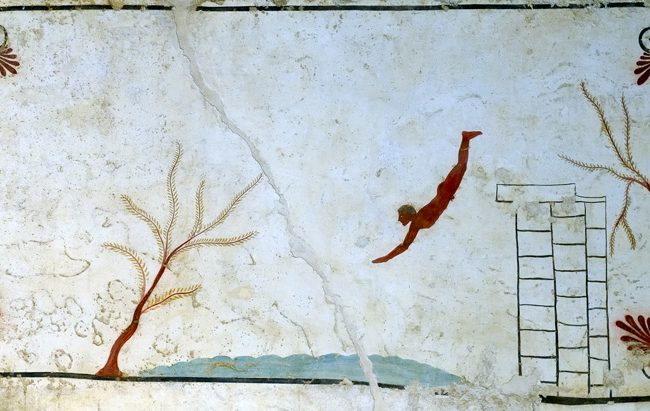
Post a Comment cancel reply
Save my name, email, and website in this browser for the next time I comment.
Privacy Overview
Necessary cookies are absolutely essential for the website to function properly. This category only includes cookies that ensures basic functionalities and security features of the website. These cookies do not store any personal information.
Any cookies that may not be particularly necessary for the website to function and is used specifically to collect user personal data via analytics, ads, other embedded contents are termed as non-necessary cookies. It is mandatory to procure user consent prior to running these cookies on your website.
Sign In Here!
Log into your account in just a few simple steps.
You don't have permission to register

Guide To Visiting Paestum, Italy’s Ancient Greek Gem
Tucked away just south of the renowned Amalfi Coast lies the town of Paestum, a vivid testament to Italy’s ancient history. If you’re gearing up for a visit, this is the ultimate guide to experiencing Paestum’s Greek and Roman wonders.
This comprehensive overview takes you on a journey through the archaeological site, highlighting all the captivating sights awaiting your exploration.
The UNESCO-listed Paestum stands as a veritable treasure trove of awe-inspiring Greek archaeological marvels, the finest on the Italian mainland.
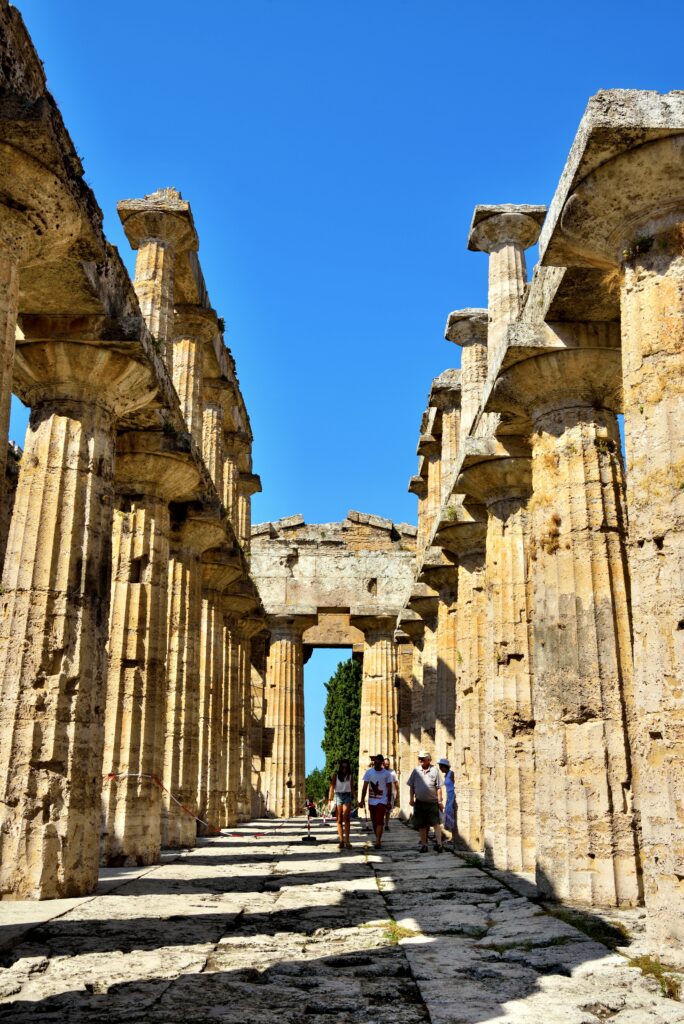
The site is only surpassed by the superb Valley of the Temples in Agrigento Sicily . But Paestum offers a more condensed and accessible experience.
>>> Click here to pre-book a Paestum ticket
What Is Paestum: A Short History
Paestum was once a vital part of Magna Graecia, or Greater Greece. It proudly showcases three exceptionally preserved Doric temples that harken back to the years 650 to 450 BC.
In the 6th century BC, the Greeks colonized the southern part of Italy, including Campania, Sicily, and Calabria. Around 600 BC, Poseidonia was established and named after the Greek god of the sea.
Paestum flourished as a Greek city, featuring an agora, roads, and splendid temples.
In the 5th century BC, the indigenous Lucanians took possession of the city. They renamed it Paestum.
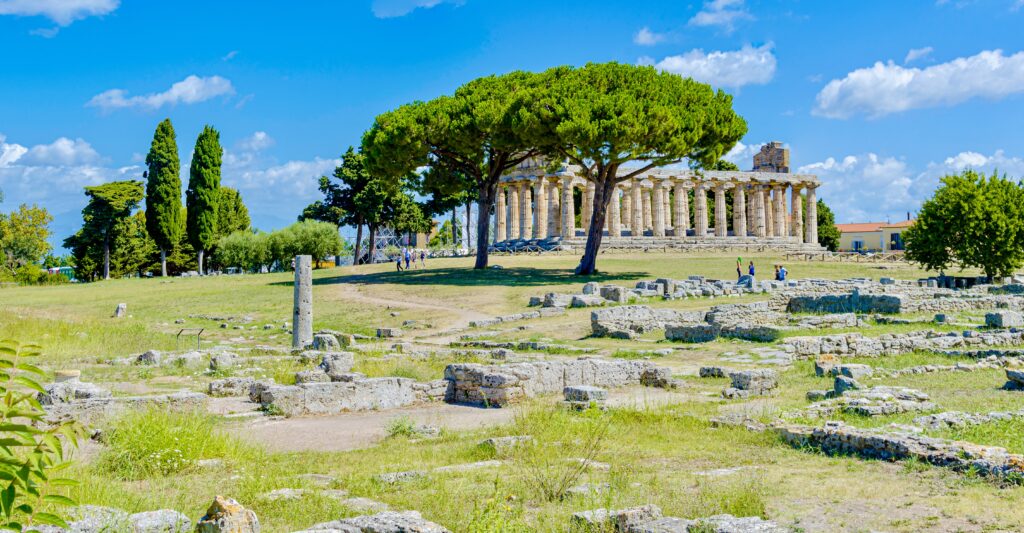
With the Pyrrhic War, Rome conquered Paestum. It was transformed into a Roman city in 273 BC. Roman structures were erected atop some Greek sites, like the Roman amphitheater and forum.
During the Middle Ages, Paestum faced a decline and eventual abandonment. The fall of the Western Roman Empire, political instability, changing trade routes, the plague, and the gradual shift of power to other regions all played a part in diminishing Paestum’s significance.
However, after centuries of oblivion, Paestum was rediscovered in the 18th century. This was about when Pompeii was unearthed and excavated as well.
In 1998, Paestum was recognized as a UNESCO World Heritage Site.
Today, Paestum boasts three remarkably preserved Greek temples, an amphitheater, forum, houses, and ancient roads. It’s a captivating journey through the ancient past!
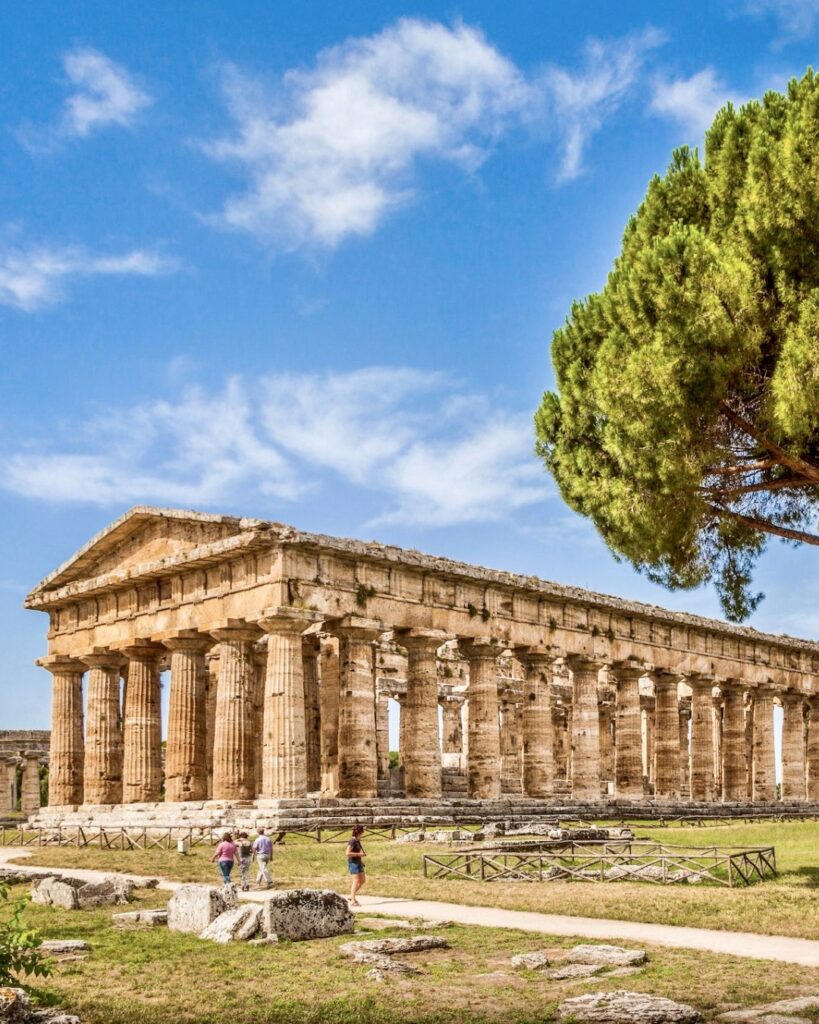
Guide To Paestum: What To See
Begin your visit at the visitor center, where you can obtain maps, information, and any necessary tickets.
Much of the forum and other parts of town are in ruins. But there are three absolutely magnificent temples and a first rate museum. Via Sacre runs the length of the site and connects the temples.
If you are a history buff, you may want to book a guided tour with an archaeologist or a 2 hour private tour .
Here’s a rundown of what you can see on a visit to Paestum.
1. Temple of Neptune (Poseidon)
As you step into the park, you’ll be greeted by the majestic Temple of Neptune, also known as the Temple of Poseidon or the Temple of Hera II.
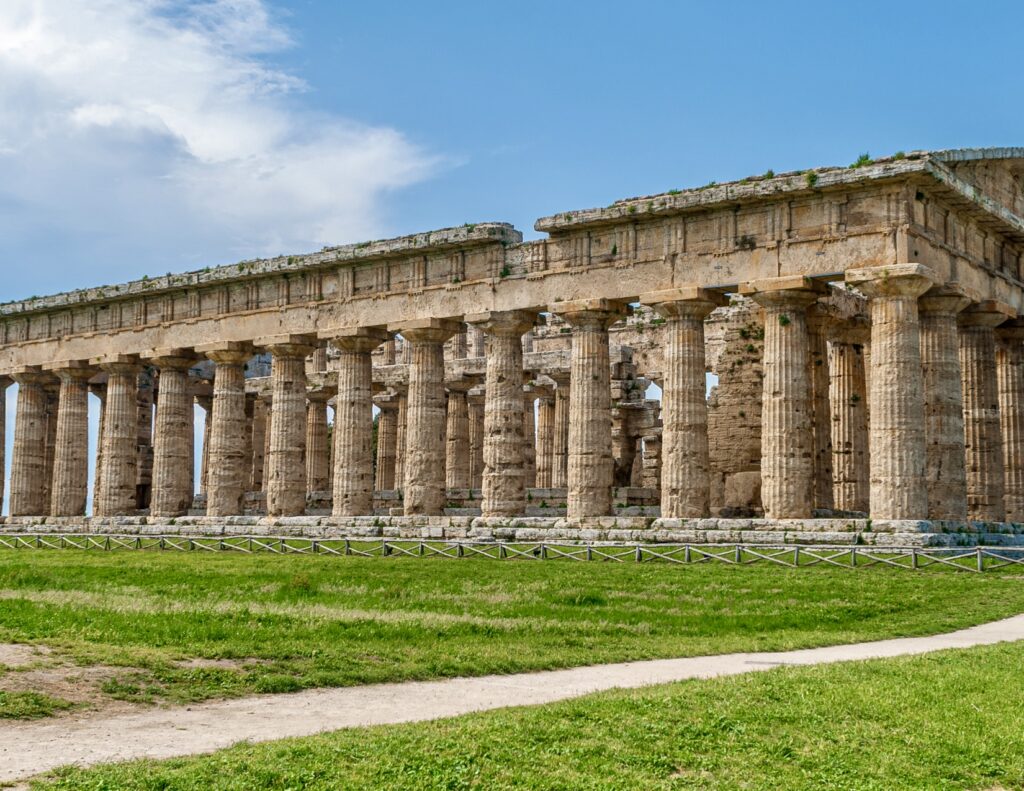
Among Paestum’s treasures, this is the youngest and best preserved of the set of temples from Magna Graecia. It’s akin to the Parthenon in Athens .
Erected in 450 BC, it stands as a textbook example of Doric architecture, capturing the essence of Italy and Greece. It’s lined in travertine stone that appears gold when the sun shines on it.
The temple stands on a high platform with six columns on the front and back, and fourteen columns on the sides. It’s known for its elegant proportions and intricate details.
The imposing columns appear lighter than they are due to the grooves carved into the shafts. The intent was to play with light and shadow and give the effect of the folds of a peplos , a traditional Greek dress.
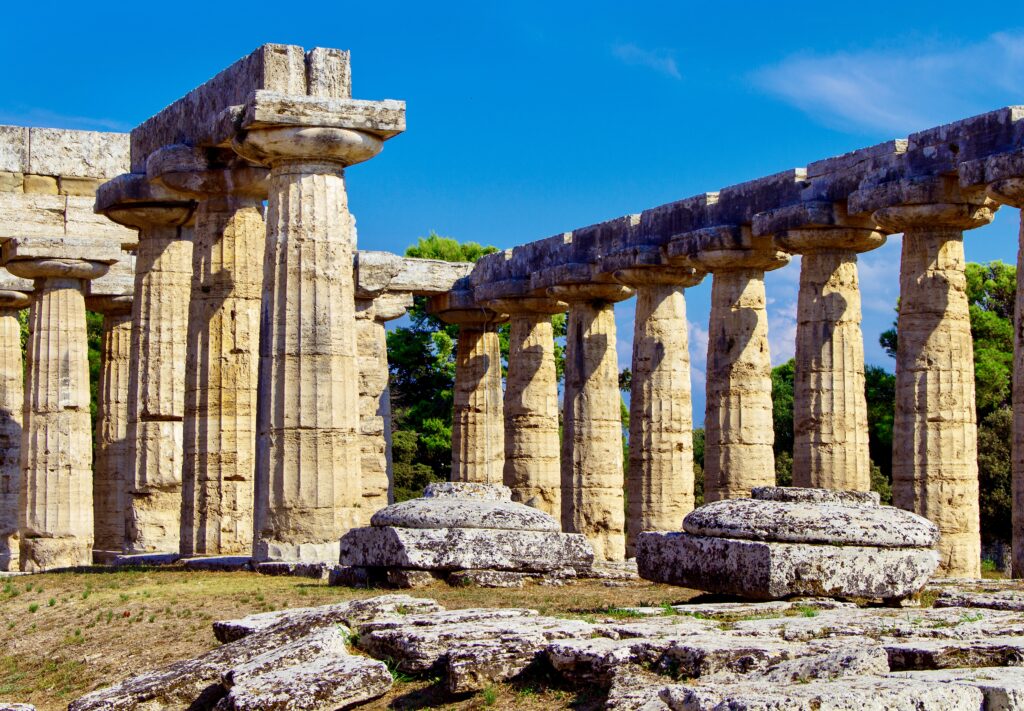
The temple’s entablature and pediments have survived nearly intact. The frieze once consisted of triglyphs and uncured metopes. Only the roof and internal walls of the cella are missing.
The cella once held a statue of the god Neptune.
In the past, scholars believed that the temple was dedicated to Neptune/Poseidon. But recent studies propose that it might have been built to honor Apollo instead.
Visitor can access the temple’s interior, although entry is limited to a small group at a time. So, a short wait in line might be required. But it’s well worth it.
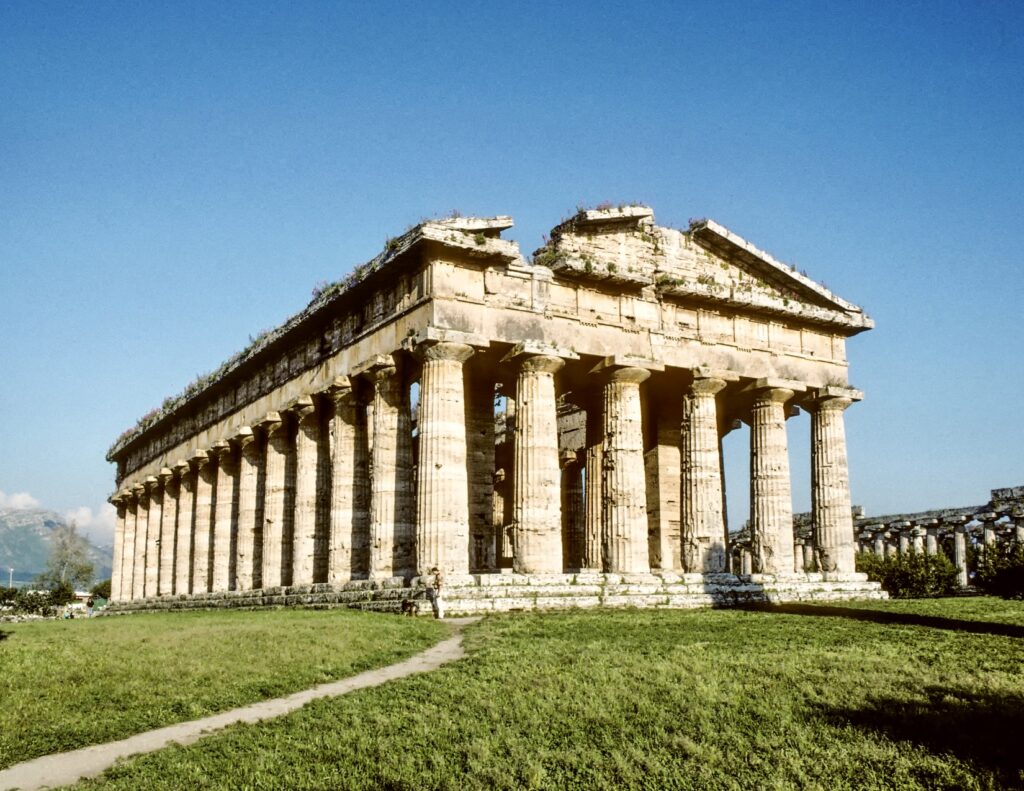
2. Temple of Hera
Built around 550 B.C., the Temple of Hera I is the oldest and smallest of the temples.
It was once known as the “Basilica,” after it was misidentified by 18th century archaeologists. They mistakenly thought the lack of pediments meant that it had a civic function.
But the discovery of ex-votos and inscriptions allowed the temple to be rightfully restored to its association with ancient Greek goddess Hera, wife and sister of Zeus. She was considered the queen of the gods and the goddess of marriage and childbirth.
The delicate temple stands on a high podium with six columns on the front and back, and thirteen columns on the sides. It’s a bit wider than most Greek temples.
A statue of the Zeus has been reconstructed from fragments found between the Temple of Neptune and the Temple of Hera. It’s in the archaeological museum.
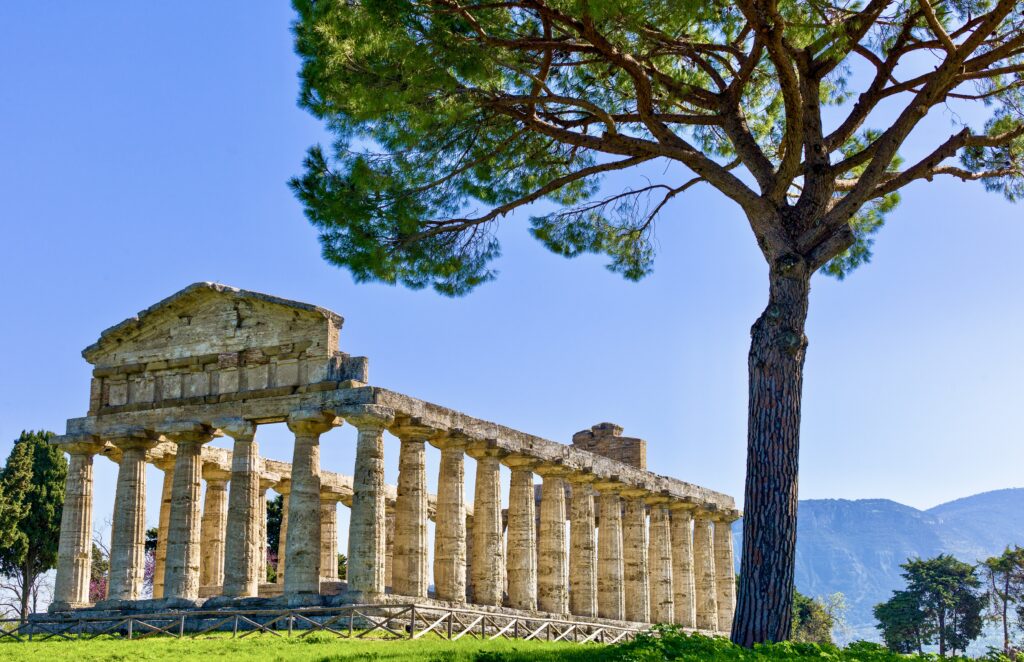
3. Temple of Athena
Constructed around 500 BC, during the zenith of Greek influence, the Temple of Athena is crafted from local limestone. It features the characteristic attributes of the Doric order, including unadorned columns with plain capitals.
The temple’s design is peripteral, enveloped by a colonnade of Doric columns that contribute to its harmonious proportions.
The temple was dedicated to the goddess Athena. She symbolized wisdom, courage, and strategic warfare in Greek mythology. It served as a center of devotion and offerings to seek the blessings of the revered deity.
The temple’s dimensions measure approximately 80 feet by 200 feet. It features a facade adorned with nine columns and eighteen columns on the sides.
Unlike the Neptune and Hera temples, you cannot go inside this one.
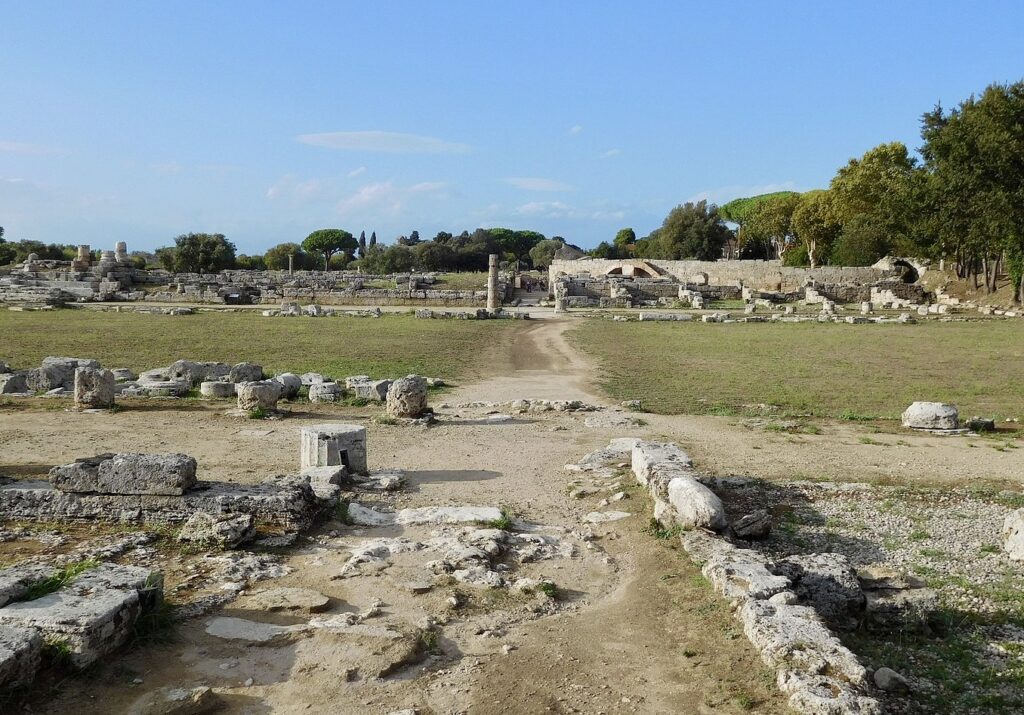
4. Roman Forum
In Roman cities, the forum was the heart of city life. The forum in Paestum was no different. And it’s in the central part of the complex.
In its present guise, the forum is the result of a layout carried out when Emperor Augustus ruled. The colonnades surrounding the square were built and the floor level was lowered.
The area was surrounded on all sides by tabernae (shops) and a macellum (covered market).
You can also make out traces of public buildings like the basilica, small shrines, and a city archive. Some of the shops even retain their original flooring.
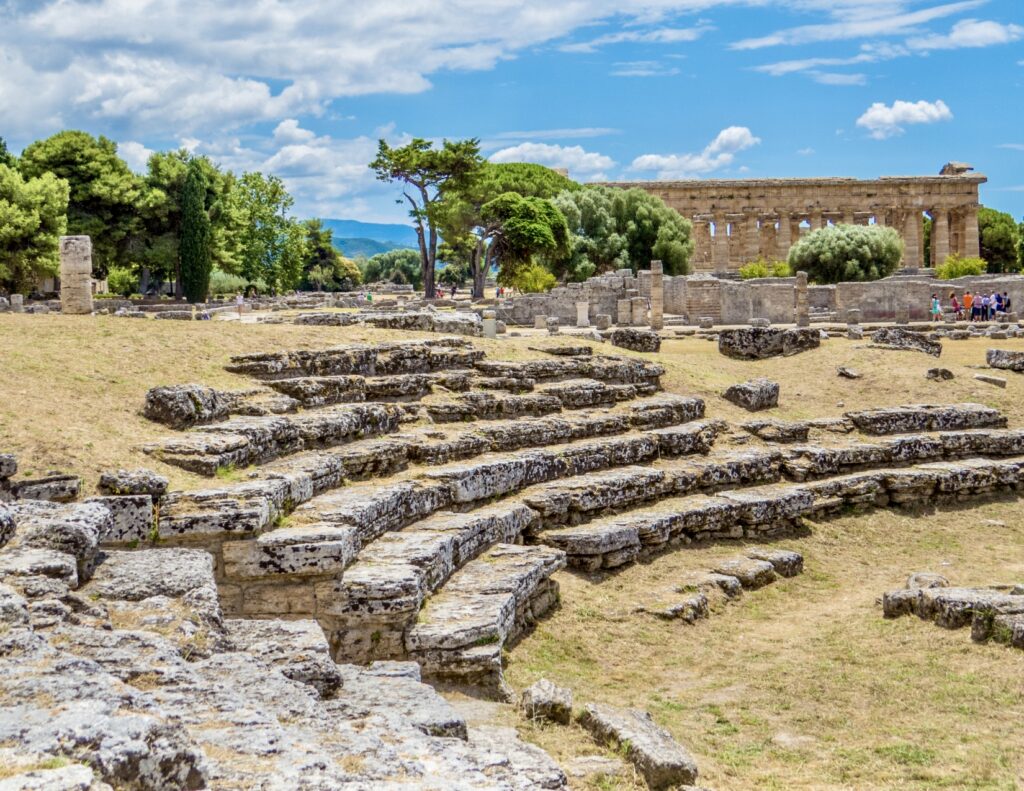
5. Amphitheatre
The Pastum amphitheater dates from the 1st to 2nd century AD. Only the western half has been excavated and is visible today.
This arena, like other Roman arenas, was used for circus shows and gladiatorial games.
The tunnel that led to the theater is still intact. It would have been used for transporting animals and props to the arena floor.
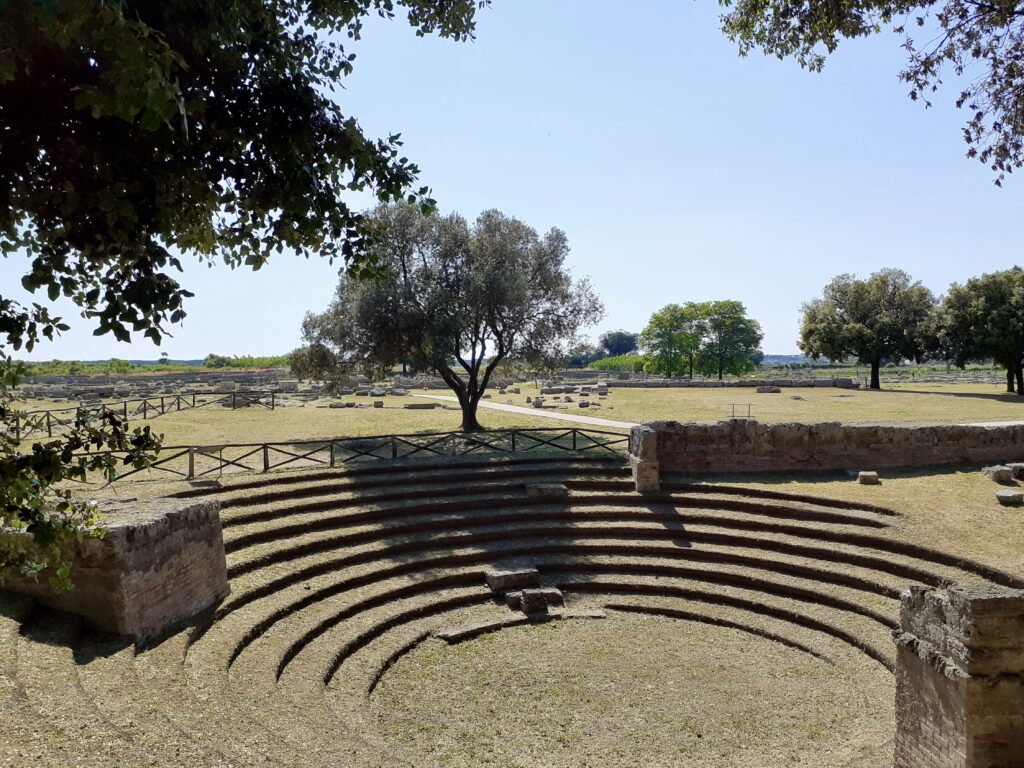
6. Ekklesiasterion
The Ekklesiasterion is oldest building in the agora, dating back to 480-470 B.C. It’s not terribly well preserved, but still offer insights into the democratic practices and civic life of the city.
The Ekklesiasterion was the citizens’ assembly hall and used for public meetings. The term ekklesia referred to the assembly of male citizens who participated in the democratic governance of the city-state.
The structure was circular in shape and had tiered seating in concentric rings. It was designed to provide clear visibility and audibility to all participants, ensuring that debates and discussions could be conducted effectively.
It was used until at least the 3rd century.
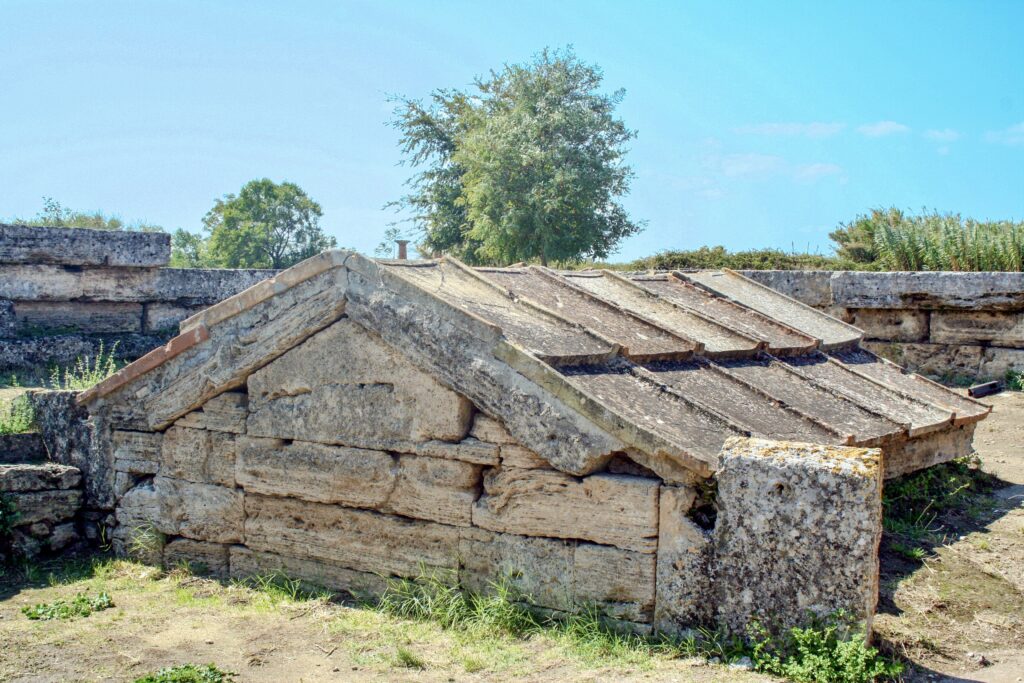
The heroon from 520 BC is located near the forum and adjacent to the Temple of Athena. A heroon is a chamber that was partially carved into the bedrock.
It’s believed to have been built to honor the city’s legendary founder, even though it was constructed around a century after his passing. This commemorative structure took the form of a simple tumulus, encircled by a protective wall made of large stones.
During its excavation in 1954, a fascinating discovery came to light at its core: a stone chamber with a pitched roof. This chamber was positioned partly below the ground level and partly above it.
Inside this chamber, a remarkable array of finds was unearthed. The included several unusual bronze vessels and an Athenian pottery black-figure amphora from 520–500 BC. Today, these artifacts are in the museum.
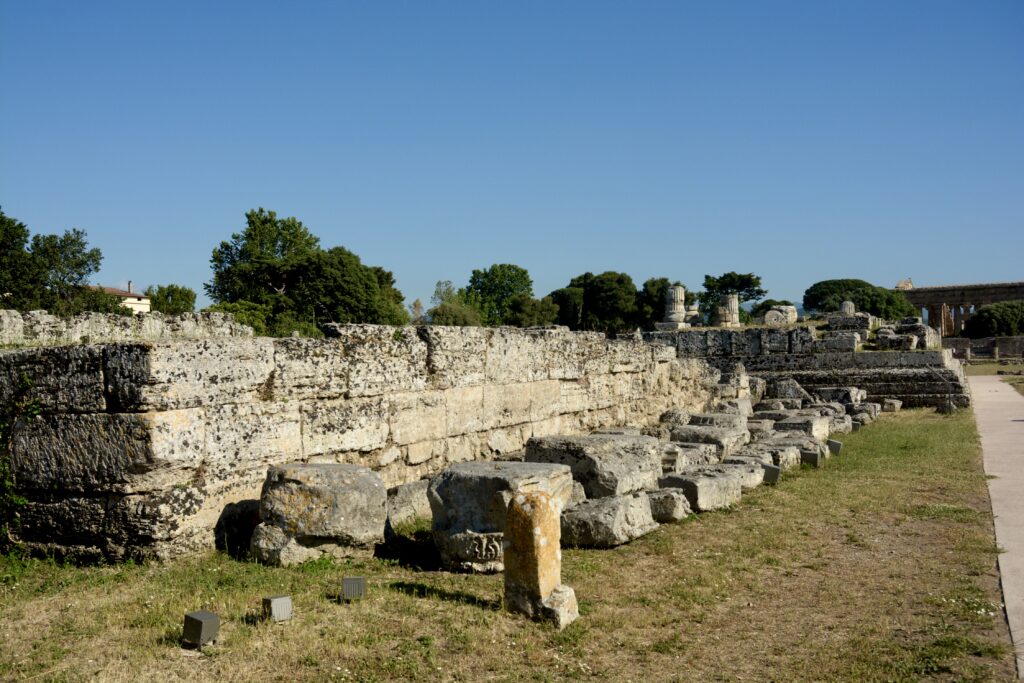
8. City Walls
The city walls of Paestum are some of the best preserved from Magna Graecia. Their building and layout took place over a period from the 6th to the 1st century BC.
Built of blocks of limestone, the walls are no longer their original height.
There were once 28 towers around the perimeter. Two of them were restored in the 20th century.
There are four gates to the city. At the Porta Marina, you can climb the walls and have excellent views of the ruins and the coast.
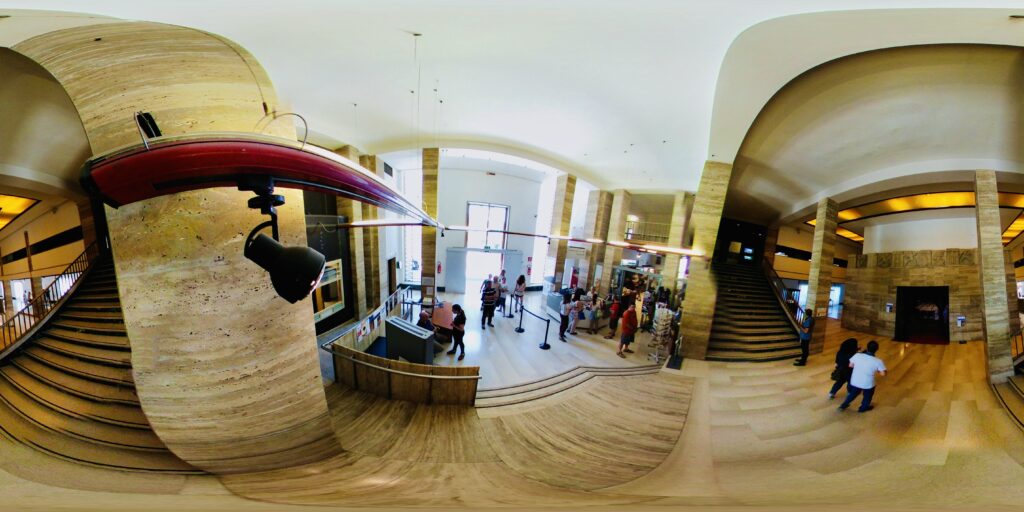
9. National Archaeological Museum Of Paestum
The Paestum Archaeological Museum is a must visit! Opened in 1952, it’s near the entrance to the site and you may want to visit this first to get a sense of what the temples once held.
This modern museum houses archaeological finds from centuries of excavation at the Paestum site. There are sections on Paestum’s prehistory, the Lucanian civilization, Greek Paestum, and Roman Paestum.
You’ll find Greek statues, terracotta pieces, Neolithic, Bronze, and Iron Age pottery, coins, jewelry, and tomb paintings.
Of particular note is a frieze from the nearby Sanctuary of Hera. The decorative panels includes mythological scenes that would have delighted a 6th century B.C. audience.
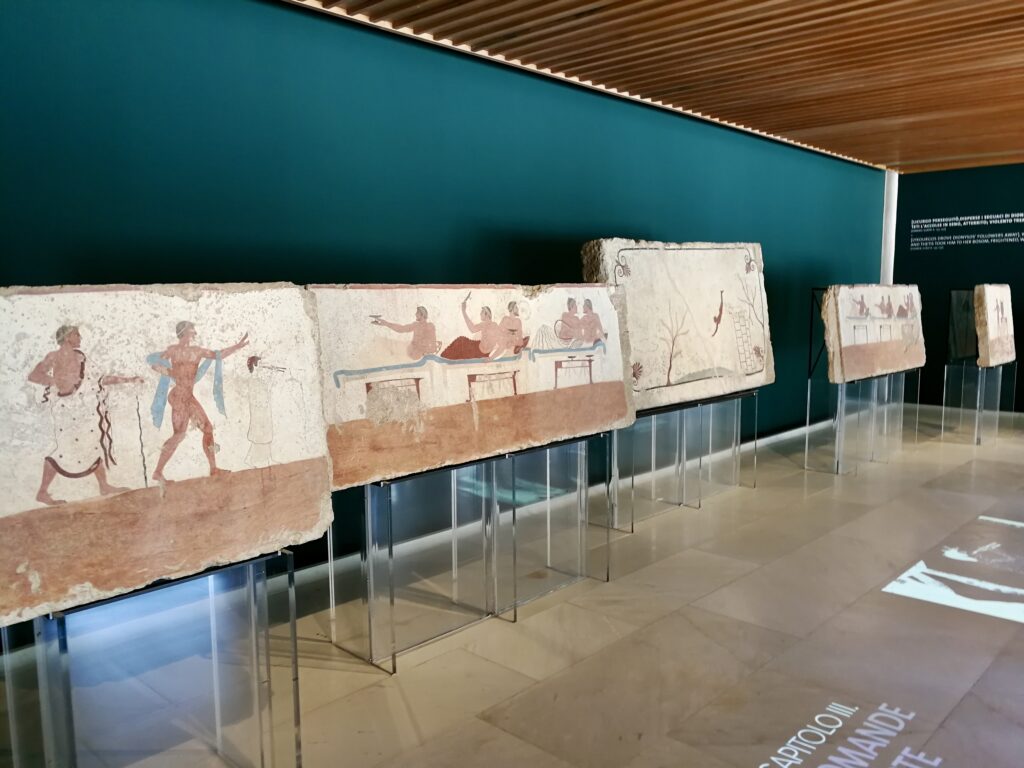
One is a comical story of Hercules and the Kerkopes. Hercules was asleep when two scamps stole his weapons.
He tied them to his pole and carried them over his shoulder. When they laughed at his hairy back, Hercules was amused and decided to let them go.
Other things to see include:
- a bronze vase from the Heroon
- a krater vase portraying the rape of Europa
- flower women votives from the temples
- painted Lucanian tombs
- dancing girl metopes from the Temple of Hera
- a 1st century portrait bust of Tiberius
- an Aphrodite vase
- red figure vases
- statuettes of Venus
- artifacts from the necropolis of Gaudo
READ : Guide To The Naples National Archaeological Museum
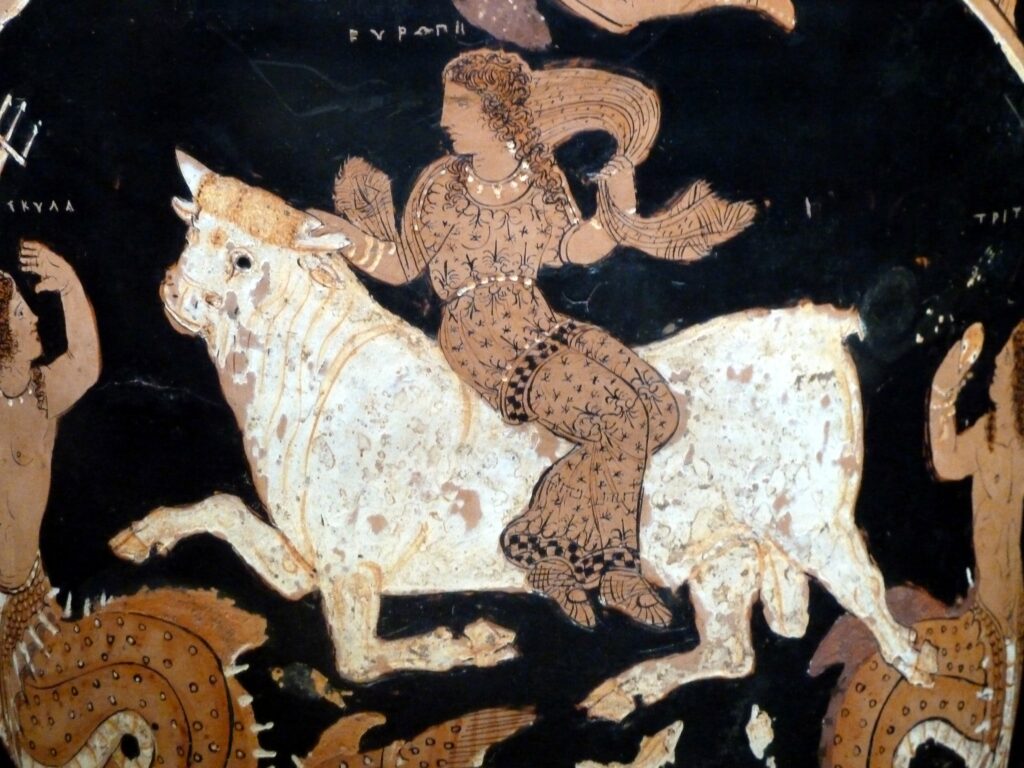
10. Tomb of the Diver
The star of the museum is the Tomb of the Diver, an ode to eternity. In 1969, a farmer in the area discovered the only known ancient Greek frescoes from a tomb dating from 470 BC. It was an extraordinary archaeological find.
There is some debate about whether it was created by the Greeks or the Lucanians. But most historians believe it was the indigenous Lucanian inhabitants of the region.
Crafted from five limestone slabs, this enigmatic tomb features four walls forming its enclosure and an extraordinary fifth slab that serves as the tomb’s ceiling or roof. It is from this captivating roof that the tomb gets its name.
The image depicts an athletic young man gracefully diving into a stream of water, almost into the unknown.
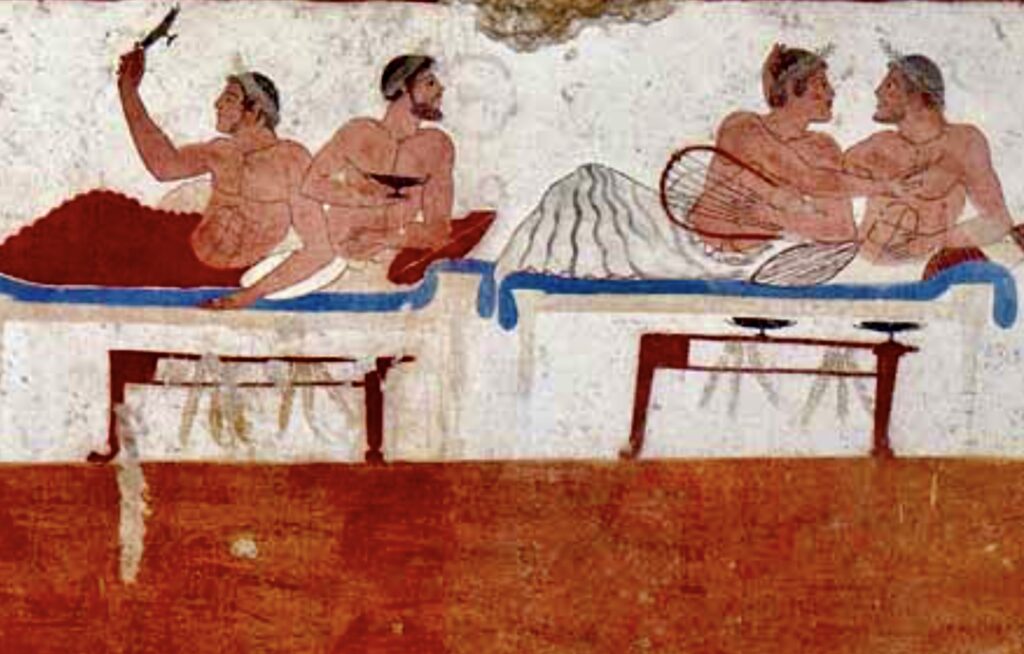
The meaning has long been debated. But it’s most likely a symbol of passing into the afterlife. Is there a new world of life beneath the water?
Inside the tomb, four walls are adorned with buon fresco paintings — true frescos rapidly painted on wet plaster.
They capture scenes of a lively symposium – basically a Greek drinking party. They are most likely giving the diver a good send off.
There are some homosexual scenes. In one of the longer panels, two lovers are on the right. Another two men sit on a couch watching them.
These paintings are unique and very significant because they represent the only known surviving ancient Greek frescoes with figurative imagery from this period.
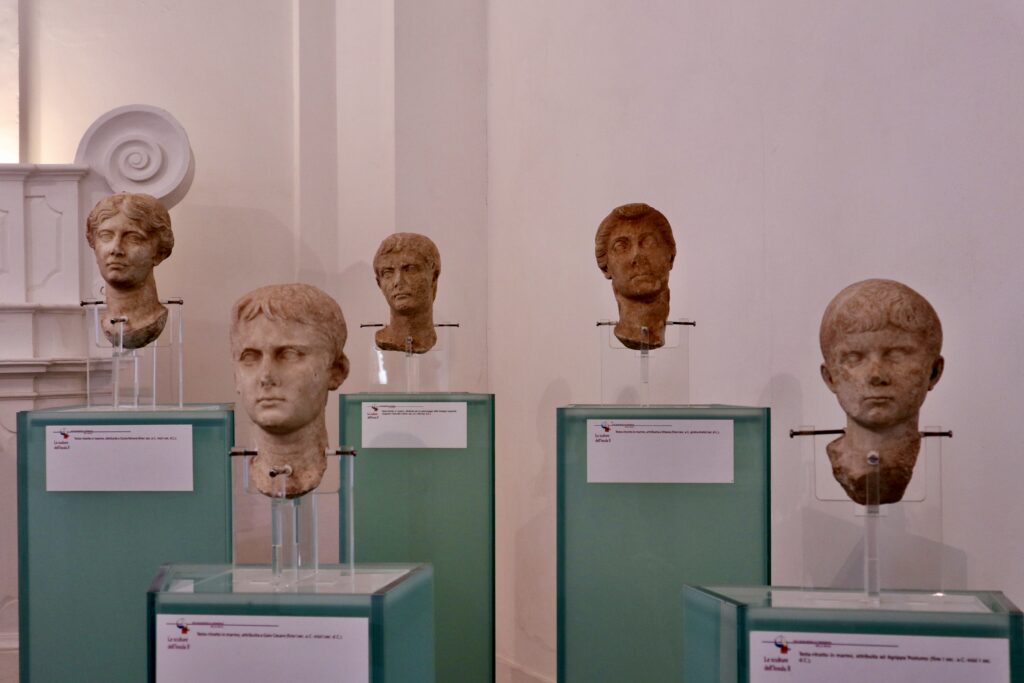
Guide To Paestum: Tips For Visiting
No guide to Paestum is complete with some must know tips for visiting the site and museum.
1. Where Is Paestum
Paestum is located in the Campania region of southern Italy. It’s situated on the Tyrrhenian Sea coast, in the province of Salerno. The town is considered to be the “capital” of the Cilento region.
Paestum is about 55 miles from Naples and 3 hours from Bari in Puglia .
Paestum is relatively close to the Amalfi Coast too, making it a feasible day trip destination from the coastal towns. Here are the times:
- Amalfi Town to Paestum : Approximately 35 miles via car, taking around 1.5 to 2 hours
- Positano to Paestum : Approximately 40 miles via car, taking around 2 hours
- Sorrento to Paestum : Approximately 56 miles via car, taking around 2 to 2.5 hours
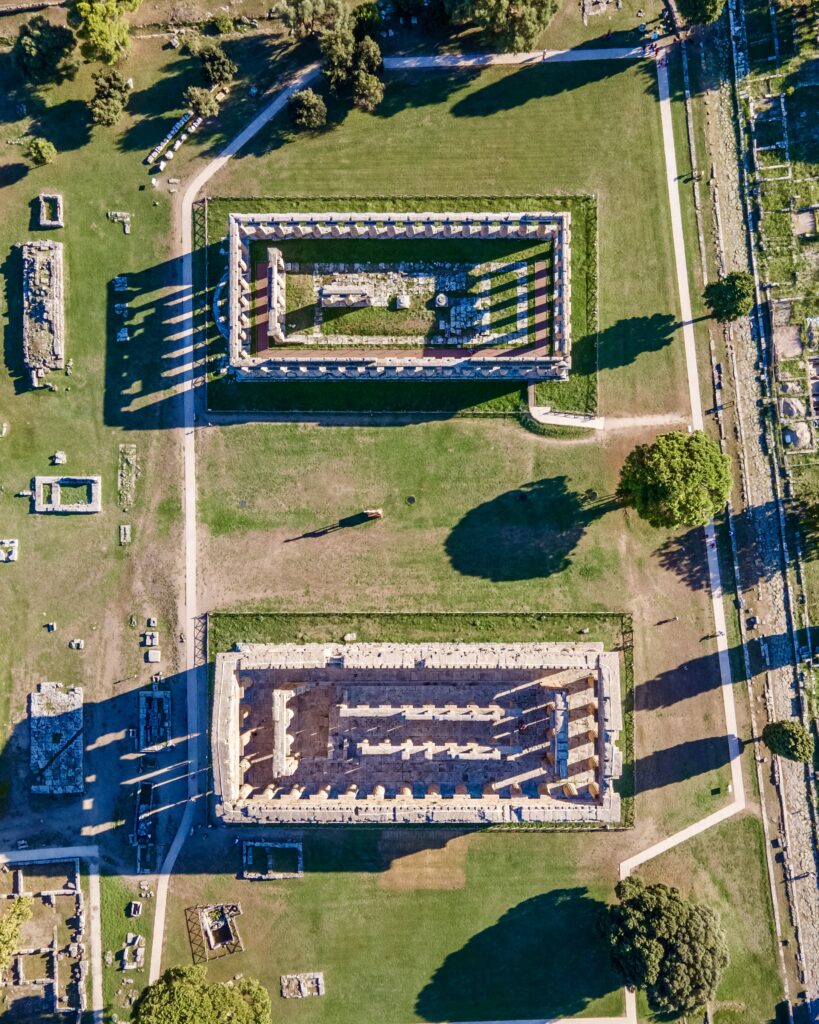
2. How To Get To Paestum
If you’re driving, follow the S18 south of Salerno. At Paestum, there are designated parking areas available for visitors.
The main parking lot is near the entrance to the archaeological site, making it easily accessible. Additionally, there are often parking spaces available along the roads leading to the site.
You should plan to arrive arrive early, especially during peak tourist seasons, to secure a parking spot.
If you are planning to take the train from Naples, you must book a regional one from Napoli Centrale. There are two train stations in Paestum: Paestum Station (Stazione di Paestum) and Capaccio-Roccadaspide Station (Stazione di Capaccio-Roccadaspide).
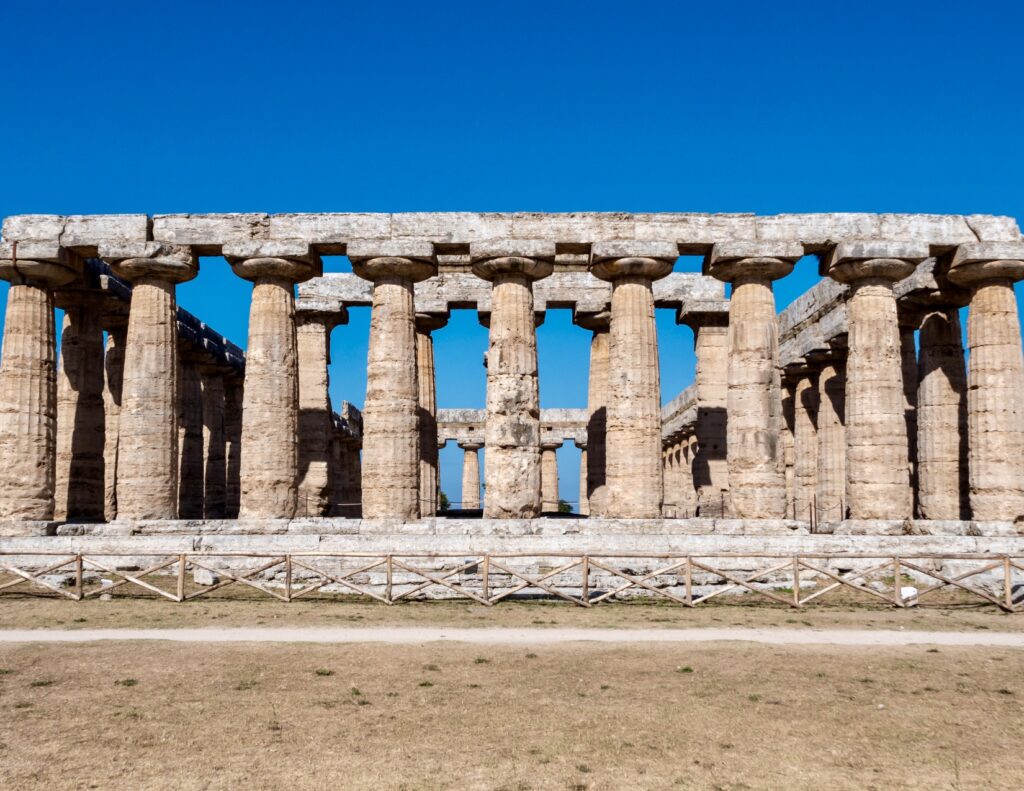
You can check times and book tickets on Trenitalia . Either station is about a 10-15 minute walk to the ruins. The Paestum one is a bit closer.
You also book a train ticket and skip the line ticket for the archaeological site here . You can also book a private transfer to Paestum from the Naples station.
If you would prefer to visit Paestum on a guided tour, that’s an efficient way to visit. Here are some options:
- guided day tour from Naples
- guided day tour from Sorrento
- Paestum & Pompeii tour from Rome
3. How To Get Around Paestum
You can just walk around Paestum. The site is designed to be pedestrian-friendly.
Well-maintained paths lead you through the different areas of the ancient city. They’re a tad uneven, so wear comfortable shoes.
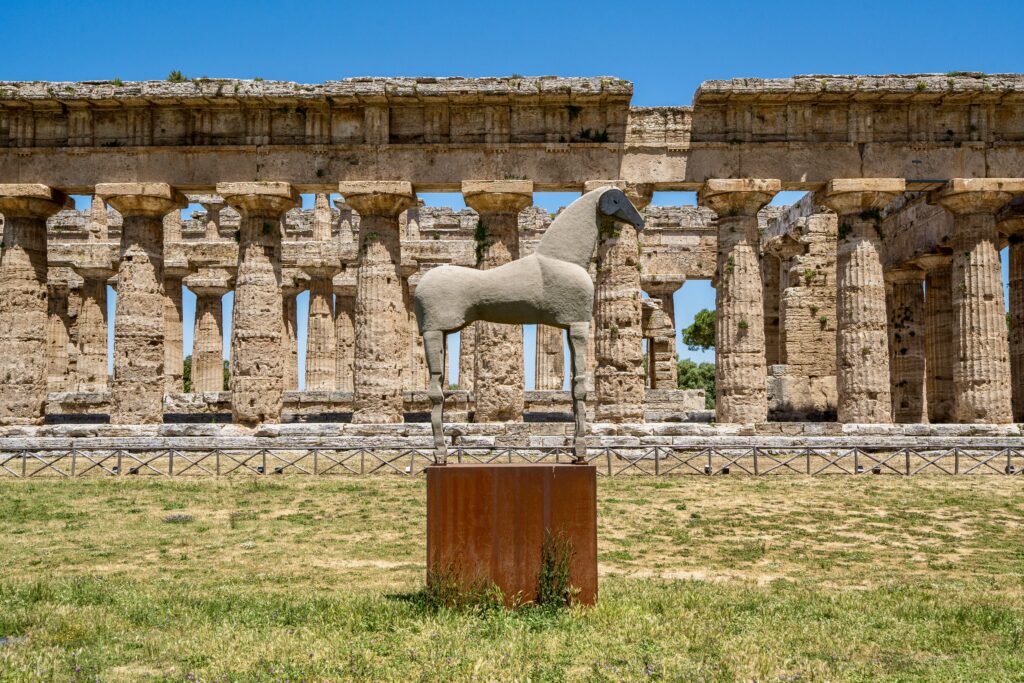
4. When To Visit Paestum
I think the best time to visit Paestum is the spring or fall. It’s less busy then than in the summer. And the scene is especially picturesque with poppies and wildflowers surrounding the ruins.
5. How Long To Spend At Paestum
Most visitors spend about 2-3 hours in Paestum. I would plan to spend at least an hour or so visiting the temples and another hour at the museum. If you have a particular interest in archaeology, perhaps more.
6. Where To Stay in Paestum
Naples makes a good base to explore Paestum. For more information on where to stay, you can check out my 3 days in Naples itinerary .
On the Amalfi Coast, the lovely Palazzo Belmonte has a private beach and is just a 30 minute drive from Paestum.
If you want something close to Paestum, you can check out the Hotel Cerere , Mec Paestum Hotel , and Hotel dei Templi .
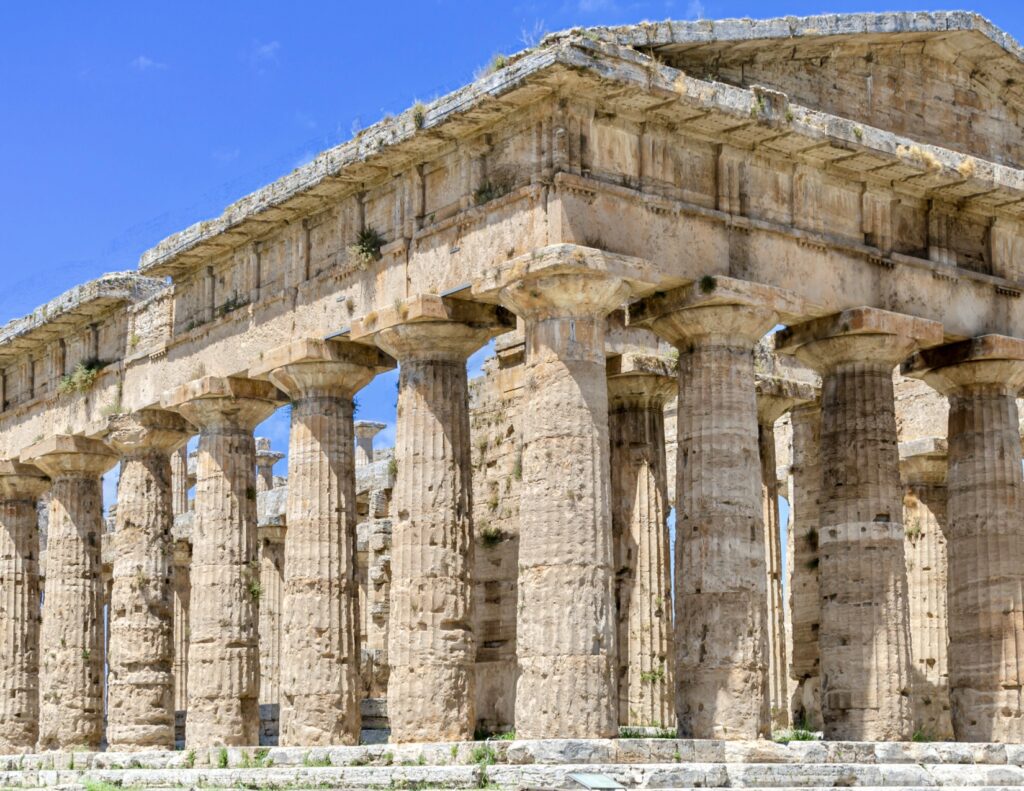
7. Is Paestum Worth Visiting?
If you are a Greek history buff or love archaeological sites (I do!), Paestum is 100% worth visiting. Paestum boasts some of the best preserved Greek ruins in the world, and certainly the best on mainland Italy.
The two things that struck me about Paestum were: (1) the incredible state of preservation of the ruins; and (2) the fact that you could walk inside them. This made the visit super enjoyable for me.
If ruins aren’t your thing, maybe you can skip Paestum. And the downside of visiting the town is that it’s a bit isolated from other attractions.
7. Other Practical Information
Addres s: Via Magna Grecia 913
Hours : Open 8:45 am until one hour before sunset. Last admission 2 hours before sunset.
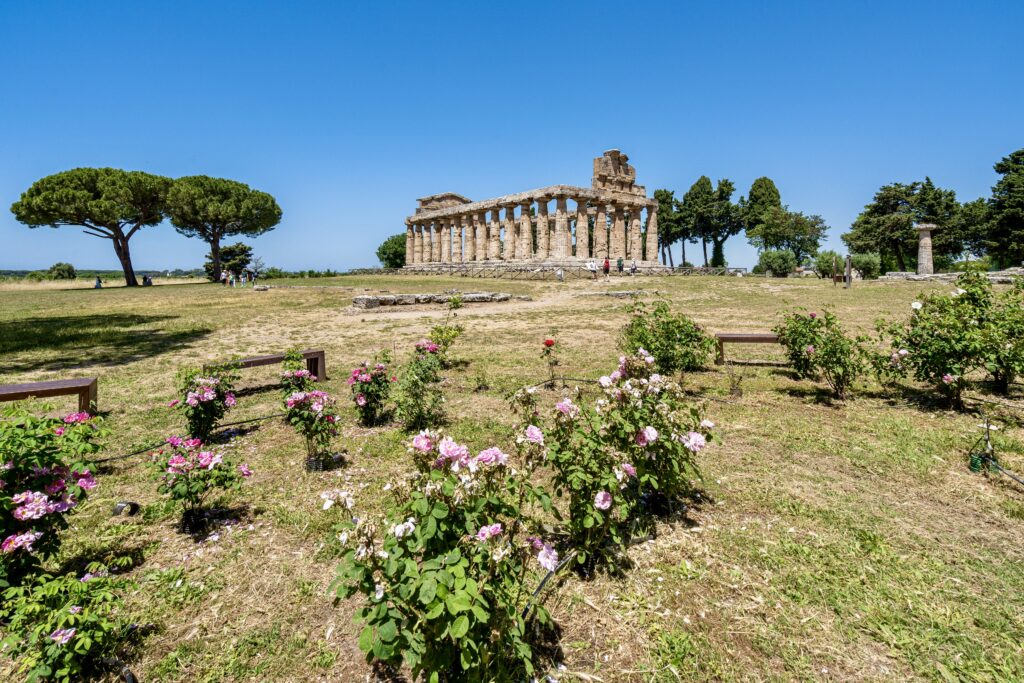
Tickest are 12 euros. In December through February, they are 6 euros.
Click here to pre-book a ticket. You can also visit Paestum with the Artecard . It comes in several versions and offers free entry to many of Campagnia’s attractions.
I hope you’ve enjoyed my guide to Paestum. You may find these other southern Italy travel guides useful:
- 10 Days in Southern Italy Itinerary
- One Week In Puglia Itinerary
- Places To Visit in Puglia
- One Week Amalfi Coast Itinerary
- One Week Rome & Amalfi Itinerary
- 5 Days on the Amalfi Coast
- One Day In Naples Itinerary
- 3 Days In Naples Itinerary
- 2 Days in Matera Itinerary
- 2 Days In Ravello itinerary
- 2 Days In Capri itinerary
- Ultimate Guide To Pompeii
If you need a guide to Paestum, pin it for later.
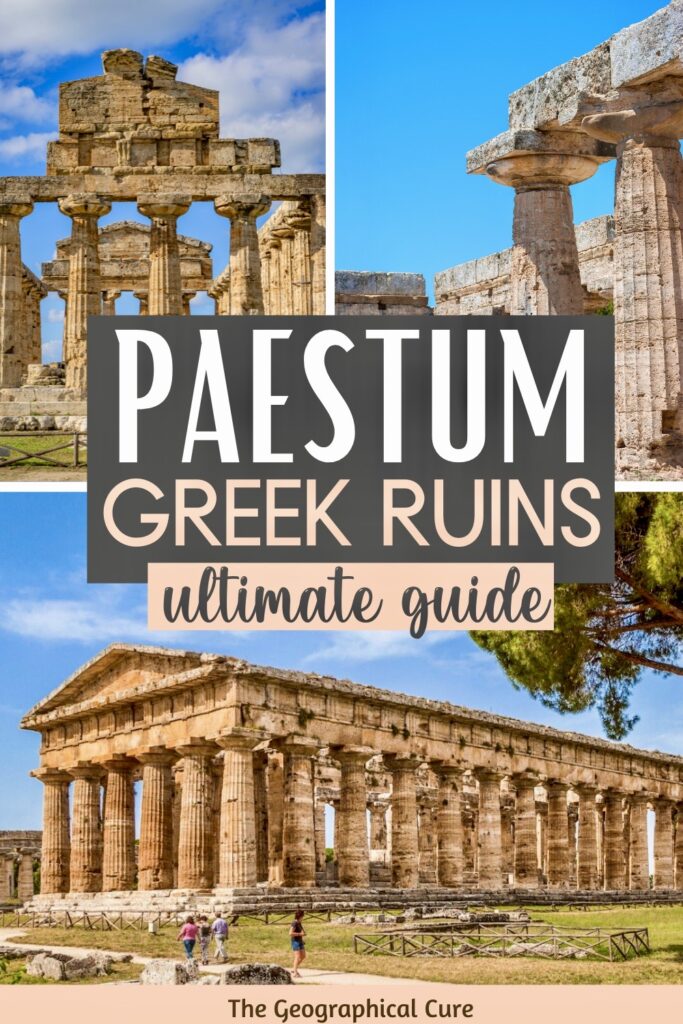
Leave a Comment Cancel reply
Save my name, email, and website in this browser for the next time I comment.
Last Updated on August 15, 2023 by Leslie Livingston
Paestum: Planning Your Visit
:max_bytes(150000):strip_icc():format(webp)/james-globe-56a3a1c05f9b58b7d0d2e4e5.jpg)
History buffs will enjoy a visit to the ancient Greek city of Paestum in southern Italy. An archaeological site, and one of the most interesting stops on the Amalfi Coast , these ruins feature three of the world's most complete Doric temples, dating back to circa 600 to 450 BCE. The temples include the Basilica of Hera, the Temple of Athena, and, on the southern end of the site, the Temple of Neptune, which was built in 450 BCE and is considered the most preserved of Italy's Greek temples .
The ruins, coined a UNESCO World Heritage site, are located in the Italian region of Campania, known for some of the best food in the country. They lie in the middle of a dense tourism zone that includes must-see locales like Pompeii, Herculaneum, the Amalfi Coast , and Naples . While there, make sure to take in the dramatic coastline and visit other ancient sites, castles, and palaces.
Around the seventh century BCE, Greece began to colonize parts of southern Italy and Sicily by founding colonies among the small, agrarian settlements. The arrival of the Greeks—in this case, Achaeans coming from Sybaris—first built fortifications on the coast, and then moved inland to build their city. The city-state of Paestum, first named "Poseidonia" in honor of Poseidon, the god of the Sea, was built in a spot chosen for its fertile plain and seaport.
The city suffered a serious population decline during the 2nd century BCE, when its economic fortunes declined due to the construction of the new roman Highway which bypassed the city. And then, late in the 1st century BCE, the city was partially affected by several earthquakes, as well as the eruption of Mount Vesuvius. After that, Paestum's drainage system became severely compromised, resulting in floods and making the swampy and mosquito-ridden area an unhealthy place to live. Many of the remaining population fled to the hills to avoid malaria, and the others who stayed fell in Saracen raids.
Paestum was "re-discovered" in the 18th century, when poets like Goethe, Shelley, Canova, and Piranesi visited and wrote about the ruins while on the " Grand Tour ." Today, Paestum contains an adjacent archaeological museum , alongside the old town, which houses collections of ancient artifacts.
A trip to Paestum takes you back to an unimaginable time by modern standards. This era can only be experienced by immersing yourself in the remnants of the three existing temples, an amphitheater, and a cultural museum.
- Temple of Hera: The Temple of Hera is the oldest of the three temples in the city of Paestum (built in 550 BCE), and was first thought by archaeologists to be a Roman public building, or basilica . Inscriptions in the temple mark its dedication to Hera, the goddess of women, marriage, family, and childbirth, and its open-air altar allowed worshippers to make sacrifices without entering the cella (holy area).
- Temple of Athena (or Ceres): This temple, thought to be used as a Christian church, was built in 500 BCE and shows early Doric architectural features. The grounds consist of a typical Roman forum, surrounded by the foundations of various public and private buildings. In the 1930s, a civil engineer built a road across the northern half of this site and was tried and sentenced for destruction.
- Temple of Neptune: The well-preserved temple of Neptune remains almost completely intact, except for the roof and a few sections of the inner walls. It contains impressive rows of columns, two altars, and statues that indicate its dedication to Apollo, the god of archery, music and dance, truth and prophecy, and healing and diseases.
- Amphitheater: Nearby the Temple of Athena sits the amphitheater, a central element of the old town, which is partially buried by the new road. Built in 500 BCE, this amphitheater is one of the earliest existing amphitheaters in the world. It's constructed in a typical Roman pattern, but only the western half is still visible today.
- National Archaeological Museum of Paestum: The Tomb of the Diver—constructed in 480 or 470 BCE and containing a plaster depiction of a man plunging into a pool of water—is one of the main attractions at this on-site museum. The museum also contains other tombs with interesting depictions that date back to the fourth century BCE. Other artifacts on display include terracotta figurines of goddesses, painted vases, and the remnants of limestone metopes.
Visiting Paestum
Paestum makes a great stop-off for anyone visiting this section of Italy, and it's best enjoyed in the slack season when the weather is mild. However, if you choose to come during the winter, you get a discount on admission fees.
- Best Time to Visit: The best time to visit Paestum is during the months of May and October, when the temperatures hover around 20 degrees C (68 degrees F) and 25 degrees C (77 degrees F), respectively. If you travel during these months, you'll avoid the tourist crowds of summer.
- Location: Paestum is located in the Province of Salerno in Campania, Italy.
- Hours: The archeological area of the ruins is open every day from 8:30 a.m. to 7:30 p.m.
- Admission: From December through February, the cost for an adult to visit Paestum is 6 Euros; admission for students 18 to 25 years of age is 2 Euros; a family pass is 10 Euros. From March through November, admission for adults doubles to 12 Euros, students cost 2 Euros, and a family pass is 20 Euros.
- Tours: Day tours include a two-hour guided Greek temple tour of Paestum and the Archeological Museum , combined with a visit to a buffalo mozzarella farm, and a tour of Paestum with a certified archeologist. These tours allow you to skip the line and enjoy the site in a small group.
Getting There
To get to Paestum from Salerno or Naples by car, take the autostrada A3 motorway to Battipaglia, exit toward SS18 (the Paestum exit). The trip is approximately 50 minutes from Salerno and an hour and a half from Naples. Paestum is also accessible by bus, with frequent service available from Salerno or Naples. CSTP bus 34 in Salerno takes about an hour to Paestum, and from Naples, the trip takes around 85 minutes. You can also take a 30-minute train ride from Salerno, or an hour and a half ride from Naples (make sure it's a local train that stops at Stazione di Paestum) . From the train station, head west, walking approximately 15 minutes and crossing through the gate in the old city wall (Porta Silena). Then, continue until you see the ruins in front of you.
Where to Stay
Since Paestum is near the Amalfi Coast, you can combine a visit to the ruins with a trip to the beach, by staying in a centralized location, like a residential vacation rental. However, you can also book a boutique hotel in Capaccio or Paestum, like the Mec Paestum Hotel or the Grand Hotel Paestum , and stay closer to the ruins. Also, since Paestum is located in a foodie-rich part of the country, world-class dining options are sprinkled throughout the area, including the popular seafood restaurant known as Ristorante Nettuno .
The Top 10 Day Trips from Naples, Italy
The 14 Best Day Trips from Rome
Italy UNESCO World Heritage Sites - Southern Italy
Capri Italy Guide: Planning Your Visit
Roman Amphitheaters in Italy
Top 18 Things to Do in Athens, Greece
Top 13 Things to Do in Salerno, Italy
The Top 14 Things to Do on the Amalfi Coast
Visit the Temples of the Greek Gods and Goddesses
The Top 20 Things to Do in Greece
22 Things to Do in Central Naples, Italy
18 Top Things to Do in Bihar, India
Molise Map and Travel Guide
Teotihuacan: Planning Your Visit
The Top 11 Day Trips From Athens
Herculaneum: The Complete Guide
An Italian Mama's Guide to Italy
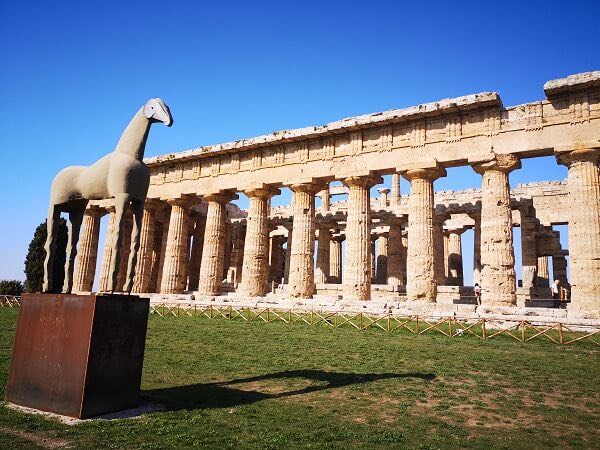
Paestum Italy: all you need to know to visit this overlooked UNESCO site and its breathtaking Greek temples
The ancient Greek city of Paestum is one of the most beautiful yet often overlooked archaeological sites in Italy. This is all you need to know to plan a visit to Peastum, Italy.
If you love history and archaeological sites, then you should make sure to include in your Italy itinerary a visit to the stunning Greek and Roman archaeological site of Paestum.
Located in Campania, less than 1 hour drive South of Salerno, Paestum is home to three Greek temples of outstanding beauty and to a beautiful museums with unique burial paintings from the V century BC.
The site entered UNESCO’s list of World Heritage Sites in 1998 and it is one of the most beautiful archaeological sites in the country and one of the best to see Greek ruins in the South of Italy.
Despite its importance and beauty, the site is largely overlooked by international tourism, probably due to its position, slightly off the most beaten track.
I highly recommend you go visit and spend a morning in this gorgeous location: you will never forget it!
You can learn how to include Paestum in your Southern Italy itinerary here
A brief history or Paestum, Italy
Paestum is an ancient Greek city originally built in this location by Greek colonies from, probably, the city of Sibaris, in the VII century BC.
Its original name seems to have been Poseidonia, a name that highlighted to special connection with the God of the Sea Poseidon, and seems to have changed name to Paistom and then Paestum respectively when taken over by the Lucanians first and the Romans next.
Poseidonia / Paestum went though a long period of prosperity and many of the ruins we see today date back to those years of wealth and power, which archaeologists place between 560 a.C. al 440 a.C. (Greek times) and then later 273 BC – 270 AD (Roman times).
Paestum seems to have become Christian relatively early and seems to have been home to Christian Bishops since the V century.
The town however fell into disgrace and was largely abandoned from the VIII century AD, when the area partially returned to be an unwelcoming swamp.
In the XVIII century the Greek city seems to have returned to some form of notoriety and eventually even entered the itinerary of the Grand Tour which mean it gained popularity among a certain section of European society.
Nowadays, the temples and the city are an archaeological park with attached an interesting museum and a wonderful place to learn about the history of this area and how different civilizations left their mark.
What to see in Paestum
Paestum is an open air archaeological site and museum, with ancient ruins of three Greek temples, houses, ancient city piazzas and artifacts.
The most impressive things to see in Paestum I believe are the three Greek temples and the museum.
The three Greek temples
The city of Paestum has three Greek temples in a stunning state of conservation.
Made of cream colored stone, they stand tall in the middle of what are now green lawns and are a vision of might and beauty against the backdrop of the Southern Italian blue sky and the frame of tall umbrella pines that surround them.
The temples are different one from the other but they are all in Doric style and where devoted to different deities, the attribution to which seems to have stumped historians in the past.
The temples are visible one from the other, two of which facing each other, and they are impressive both as a whole and individually.
The temple of Neptune
The temple of Neptune in Paestum dates back to the V century a.C. and is a sight to behold.

It has three naves and is entirely surrounded by Doric columns made of golden-colored travertine.
The columns are large and heavy but they are decorated with splendid vertical grooves: they capture the light as it hits the columns and create a wonderful game of shades that make this massive stone creation look as if it was feather-light.
You feel small inside it but the sun streaming in from the open roof also makes you feel part of this magnificent creation: it is really easy to see why this was a religious building, the effect on the visitor is truly powerful!
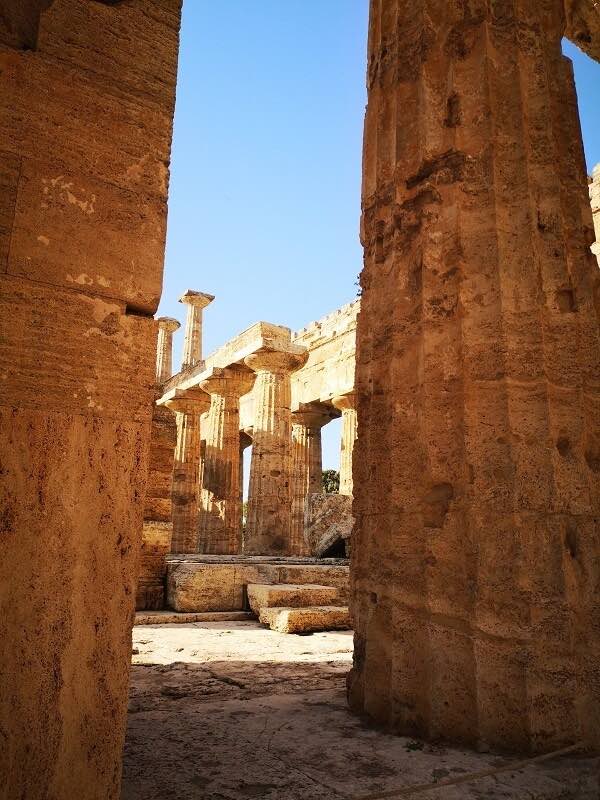
The temples of Neptune is said to be the best-preserved temple in the Greek world and is also unique.
The double order of columns that divide the tree naves of the temple is unseen in the Western Greek world and makes this temple the only example of this type of architecture in Magna Graecia .
This structure also connects this temple with the much more famous yet less preserved great temple of Zeus in Olympia, in mainland Greece.
The Basilica
Beside the temple sits another building, smaller yet somewhat similar, often referred to as ‘the basilica’.
It got this name in the XVIII century, when archaeologists thought this was an administrative type of building however, archaeologists now believe it was original a temple to Hera and / or Zeus.
It dates back to 530 a.C and had, inside, several religious artifacts now preserved in the local museum.
The basilica is stunning: it is in excellent state of preservation and has some special traits that make it stand out.
One is the odd number of columns at its front and the other is the peculiar shape of the columns itself, narrower at the top, two architectural elements that give away the archaic origin of the building.
The temples of Athena or Temple of Ceres
A little detached from the two other temples lies another religious building identified as the temple of Athena or Ceres.
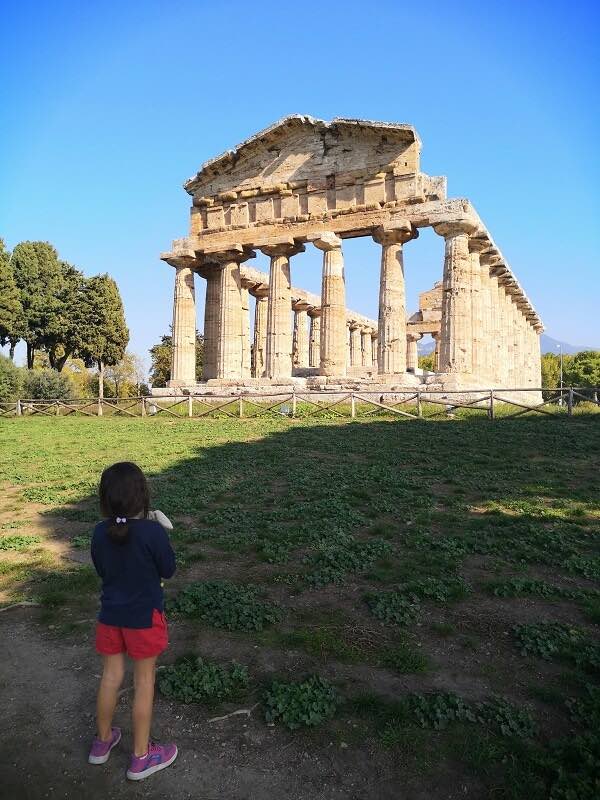
This is a wonderful Doric temple and likely the first you encounter when entering the park: the temple is framed by pine trees and flowers is a little detached from the other two, which you can however easily see and reach from here.
The temples seems to have been built after the basilica but before the temple of Neptune and has some peculiarities that make it unique: its plan is simpler than that of the other two temples and its pediment is also unique because of its Doric decoration.
Paestum’s Archaeological Museum
Immediately outside the precinct with the temples, you find the beautiful and well kept Paestum Museum, which holds several ruins and artifacts from the temples / city area and additional finds from the area.
The most famous of all are the incredible burial paintings knows as ‘diver’s tomb’ or ‘t omba del tuffatore ‘ in Italian.
The tomb of the divers dates back to the V century BC and it is a rare example of Greek embellishment of a burial space.
This is an exquisite painting of a diver taking a symbolic dip into the world of the dead and also has depictions of colorful symposium / banqueting scenes.
The tomb is unique and worth seeing, and complement spectacularly the beauty of the temples just in front.
Practical tips for visiting Paestum, Italy
Paestum is best reached by car. Its locality is called Capaccio, which is a small nondescript town in Southern Campania.
The drive here is easy and once you get to the temples you find shops, restaurants, parking lots and facilities for tourists.
To visit the park I recommend you wear good walking shoes or walking sandals.
The terrain is not particularly challenging or difficult and it is vastly flat however, this is an archaeological site so uneven terrain and grassy and dirt patches are the norm.
The site can be visited in a couple of hours and it is possible to have lunch just outside with view over the temples.
Opening hours: 9:00 am to 7:30 pm [last entrance 6:45 pm] from Monday to Sunday. Please note that the museum is closed on Mondays. 2020 rules and regulations may affect this hours.
Paestum entry ticket prices:
from December to February
- Full price : € 6 .
- Reduced (from 18 to 25 years): € 2.
- Family (2 adults + one or more children and young people up to 25 years): € 10.
from March to November
- Full price : € 12 .
- Family (2 adults + one or more children and young people up to 25 years): € 20.
Visiting Paestum with kids
Paestum is one of my favorite archaeological sites in Italy to visit with kids . It is rather contained in size, therefore not overwhelming, and it has a lot of open spaces that are good for kids to run and explore in their own time.
The temples are fun for them to visit and there are simple enough information panels that, with the aid of an adult, can help them make sense of what they see.
The presence of the restaurants and cafe make this an easy place to visit in terms of logistics too and the car park is literally just in front of the temples.
I recommend you bring al all terrain stroller or do without for the duration of the visit.
Organized tours and day trip to Paestum
We visited Paestum on our own and I believe if you have a car, the information available on site and at the museum are sufficient to enjoy your day and learn about the place.
If you don’t have a car or want to learn more about this site, there are day trips and day tours available.
You can check out the following (please note: these are affiliate links and, should you make a purchase though them, we might make a small commission at no extra cost to you. The links lead you to GetYourGuide, our favorite ticket and booking platform)
- 2h Temple and Archaeological museum of Paestum guided tour
- Paestum Temples and Museum Tour with guide
- Paestum and mozzarella farm tour from Naples (indeed, this is mozzarella di bufala land!)
- Paestum and buffalo farm day tour from Sorrento
What to see near Paestum
Paestum is less than an hour South of Salerno, the getaway town to the Amalfi Coast and can be easily reached by car from there.
We drove here from Matera and the drive took approximately 2.5 hours, on easy roads.
If you want to have a dip in the sea, the town of Agropoli and the pretty beach of Trentova are a very short drive from the temples.
I hope you enjoyed this quick overview and tips for visiting Paestum Italy and it inspired you to go! Safe travel planning.
Marta Correale
Marta Correale is an Italian mama of two. Born and raised in Rome, Marta has a passion for travel and especially enjoys showing off Italy to her kids, who are growing up to love it as much as she does! A classics graduate, teacher of Italian as a second language and family travel blogger, Marta launched Mama Loves Italy as a way to inspire, support and help curious visitors to make the most of a trip to Italy and learn about Italian culture on the way.

You May Also Like
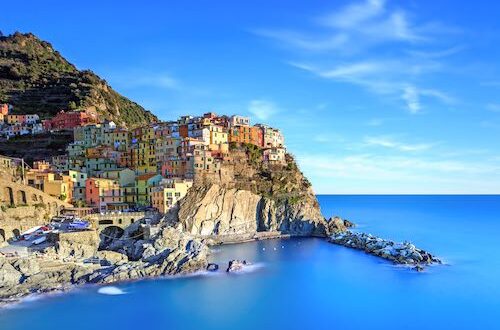
The best town to stay in Cinque Terre: how to choose the perfect one
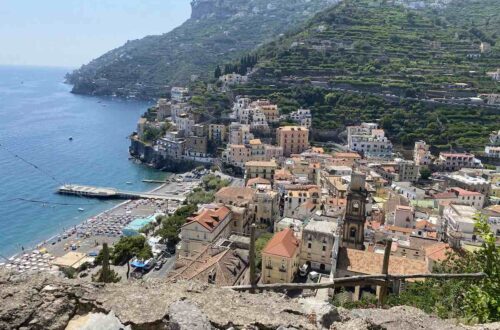
The Path of Lemons: all you need to know about this scenic Amalfi Coast hike
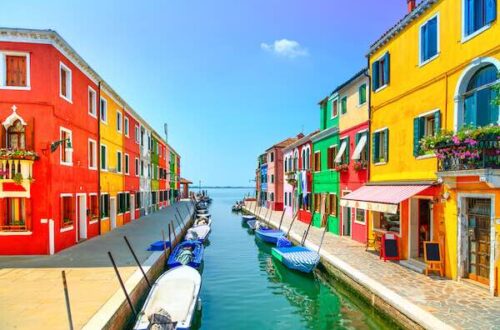
Visiting Burano: all you need to know about Italy’s most colorful town
Privacy overview.
- Nessun risultato per
- Letteratura
- Teatro e Danza
- Orchestra RAI
- Accadde oggi
- Agenda culturale
- Foto Gallery
- Domande frequenti
- Privacy policy
- Caleidoscopio
- Nuove tecnologie
- Mostre storiche
- Approfondimenti
- Contemporanea
- Music Icons
- D'autore
- Teatro classico
- Teatro contemporaneo
- Scienze sociali
- Storia della filosofia
- Filosofia della scienza
- Ecologia e ambiente
- Scienza dell'alimentazione
- Scienze naturali
- Scienza della Terra
- Biglietteria
Paestum e il Grand Tour
Una visita con philippe daverio.
Paestum riemerge dall'oblio a metà del Settecento, grazie a studiosi, giovani e cosmopoliti, che spostano le mete del Grand Tour formativo verso il sud d'Italia. Rispetto alle allora recenti scoperte delle dissepolte città di Ercolano (1738) e Pompei (1748), la greca Poseidonia era sempre stata lì, sommersa da una rigogliosa natura ultramillenaria
Nel 273 a.C., Roma vi insedia una colonia di diritto latino e la città diventa Paestum. I rapporti tra pestani e romani sono sempre stretti e fidati, tanto che l'antica polis batte moneta propria e prosperava nell'economica, mentre assorbe il nuovo riassetto urbanistico romano, con opere pubbliche e strade di comunicazione interna
Nel 1759, Winckelmann pubblicava le sue prime osservazioni sull'architettura ( Osservazioni sull'architettura degli antichi ), cogliendo l'importanza storico archeologica dell'ordine dorico, il più antico dei tre ordini architettonici, la cui "nobile semplicità" aveva forgiato l'immagine della Grecia classica di Pericle.
- neoclassicismo
- Johann Joachim Winckelmann
- 1 Understand
- 2.1 By train
- 3.1 By foot

Paestum (or the Archaeological Park of Paestum [dead link] ) has been a UNESCO World Heritage site since 1998. It is in Campania , Italy , and is an ancient Greek (then Lucanian, later Roman ) settlement, with the best preserved Greek doric temples worldwide. It is surrounded by a Roman city wall, and is 40 km south of the city of Salerno .
Understand [ edit ]
Most of the ancient Greek/Roman city has not been excavated yet. Three magnificent Greek temples, dating back to the colonization of Magna Graecia (Southern Italy), around the seventh century BC, are preserved together with other Greek and Roman ruins. The construction of the three temples is dated between 550 and 450 BC. Besides the three Greek temples, the site has an ancient gymnasium, amphitheater, city wall and tower ruins, and plenty of Roman house wall ruins. Adjacent to the main entrance to the archaeological area is a modern Archaeological Museum, displaying excavated items such as statues, vases, metalwork, and painted grave stones.
The site has been a tourist attraction for centuries. It was a common destination on the Grand Tour of the 17th to 19th centuries, as an example of the Ancient Greek heritage. In these times, in fact, Greece was part of the Ottoman Empire .
Get in [ edit ]
By train [ edit ].

A regional train goes from Salerno or Naples to Paestum station; it takes about 0.5 hr from Salerno (or 1.5 hr from Naples) to Paestum. The train is probably the fastest way to arrive with public transportation. Read about the unified public transport ticket Campania Unico . Buy your ticket to get out in one of the souvenir shops close to the museum or, better yet, before you go. No ticket sale anymore at the Paestum station and machine rarely works. The train station is located due east, within easy walking distance, of the archaeological park and museum.
By bus [ edit ]
- Ferry during summer months from Naples , Positano , Amalfi to Salerno . CSTP bus 34 leaves from Piazza della Concordia in Salerno by the base of the ferry dock roughly every hour and takes about one hour to get to Paestum. Alternatively, you could walk a few blocks from the Salerno ferry dock to the Salerno train station and take the train.
- Coaches run throughout the Campania regions, especially in Avellino province, picking locals up for various points and taking them to the site for €9 return.
By car [ edit ]
Get around [ edit ].
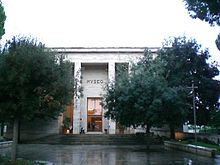
The area in and around Paestum is flat and easy countryside to get around. A jpg map is available online. [dead link] Here is the general layout. The ancient settlement is surrounded on all four sides by a Roman wall and gates on the four ordinates. Via Magna Grecia is the modern road that cuts through the middle of the walled old city from north to south. Via Tavernelle or Via Porta Aurea is a modern road just outside the north city walls, and Via Nettuno or Via Porta Giustizia just outside the south city walls. The train tracks are outside the east city walls, and the beach outside the west city walls. The Archaeological Museum and the tourist information booth on Via Magna Grecia, natural focal points for any visit, are in the middle of the walled Paestum.

By foot [ edit ]
From the train station, walk west through the old city gate ( Porta Silena ) and continue straight ahead about 10 minutes along a pleasant flat country road to a hotel on Via Magna Grecia, then turn right and walk north to the main entrance to the archaeological park and the two-story modern National Archaeological Museum. Buy your tickets for the archaeological park from the museum. The museum is also a good place for tourist information and rest rooms.
Buses from Salerno stop on Via Magna Grecia near the south entrance to the archaeological park; to get to the main entrance, just walk north on Via Magna Grecia to the museum.
From the historical site to the beach is about 30 minutes further to the west.
See [ edit ]
- Three ancient Greek temples . There are three magnificently preserved Greek temples on the Paestum archaeological site, but they have all been erroneously designated in the past. Even the signage on site and maps do not always match the most current attributions. The designations change because of newly excavated evidences of the use of the temples. Perhaps further research would call for changes in the current attributions, but that is a scenario for future travelers. For present day travelers, the Greek temple in the northern part of Paestum is identified as a Temple of Athena, and the two Greek temples in the southern part of Paestum are identified as two temples of Hera. All three temples are oriented east-west, with the front facing the rising sun. The oldest temple is the southern most one, the Temple of Hera I (also erroneously called Basilica), built around 550 BC. The temple is wider than most Greek temples, with nine columns across the front and eighteen along the longer sides (9x18). The next oldest of the three temples is the Temple of Athena (also erroneously called Temple of Ceres), built around 500 BC on the highest point of Paestum, which is north of the ancient center of town. It has six columns across the front and thirteen along the sides (6x13). It is the first known temple in the world to mix the Doric columns of the main peristyle with the Ionic columns used in the porch (see Museum). The third oldest is the best preserved Greek temple in Paestum and perhaps the world -- the Temple of Hera II (also erroneously called Neptune Temple or Poseidon Temple), built around 450 BC. It is just north of the Temple of Hera I, and it has six columns across the front and fourteen along the sides (6x14). It belongs to a transitional phase between the archaic and the classic Doric order and incorporates subtle architectural refinements peculiar to the classic Doric order. For example, the base on which the columns rest is not completely horizontal, but humps up slightly in the middle along the sides to offset the illusion of sagging. The Temple of Hera II in Paestum is modeled closely after the Temple of Zeus in Olympia, foreshadowing the most celebrated classic Greek temple, the Parthenon in Athens .

- Other Greek features . In addition to the three majestic Greek temples, there are two other notable Greek archaeological features. One is Heroon , a Greek memorial tomb, c 520 BC, which sits unexpectedly in the middle of the settlement. Well preserved vases found in Heroon are on display at the Archaeological Museum. Across the street from the Museum is a sunken circular Ekklesiasterion , c 480 BC, a civic assembly area large enough for about 500, evidence that Paestum was a democratic Greek city-state.

- Roman ruins . In between the Athena Temple in the northern part of Paestum archaeological site and the Hera Temples in the southern part are many Roman ruins, including an amphitheater, house wall ruins, and Via Sacra, the main street of the ancient settlement. The Roman Forum was the ancient center of town. As with the Greek settlement, much of the ancient Roman settlement have yet to be excavated.
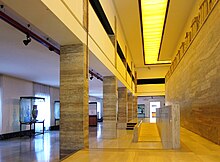
- National Archaeological Museum at Paestum , Via Magna Grecia , ☏ +39 0828 811 023 , +39 0828 722654 . daily 08:30– 19:30 (last admission: 18:50) except on the 1st and 3rd Monday of each month because of maintenance, the museum will be open until 13:40 (last admission: 13:00) . Highlights of the two-story museum include: the Sele metopes, the frescos of grave chambers, especially the Tomb of the Diver, the contents of the Heroon, and the 1943 World War II allied invasion of Italy at Paestum. Open Ticket (Museum + Archeological Area): €9. Combo ticket (Museum+ Archeological Area + Ruins of Velia) €10 valid for 3 days . ( updated Nov 2016 )
- Buffalo farms are famous for their mozzarella cheese. Buffalo mozzarella from Campania bears the "Mozzarella di Bufala Campana" trademark.
Do [ edit ]
- After visiting the antiquities, relax at beach.
Buy [ edit ]
- All the souvenirs you forgot to buy anywhere else in Italy , and they are even cheaper than elsewhere.
- Small fake jumping athlete (from the grave frescos).
Eat [ edit ]
Around the museum are plenty of Italian restaurants serving the standard food. Try the buffalo mozzarella cheese. It is enjoyed with calzone, vegetable, salad, on pizza, on grilled bread, with tomatoes, or by itself accompanied by olive oil.
- [dead link] La Basilica Café ( bar pizzeria ), Via Magna Graecia, 881 ( just north of the Archaeological Museum ), ☏ +39 828811301 , [email protected] . Good and inexpensive food. €5-8 pizzas . ( updated Nov 2016 )
Drink [ edit ]
Sleep [ edit ].
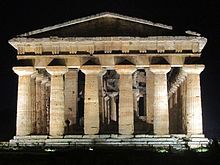
- Hotel delle Rose , Via Magna Grecia 943 ( on street bordering the ruins ). €35 single to €85 quad . ( updated Nov 2016 )
- Holiday Village Parco Elena , Contrada Impiso, 84076 , ☏ +39 0974 841491 , fax : +39 0974 841491 .
- Il Cannito Hotel ( Il Cannito Hotel ), Via Cannito, 84047 Paestum , ☏ +39 0828 1962277 . Small luxury design hotel immersed in the green, 5 km away from Paestum center. Only 4 rooms, internal restaurant and panoramic terrace. Room rates from €200 .
- 40.436293 14.979347 1 Oleandri Resort Paestum - Hotel Village Residence Club , Via Poseidonia 177 . With a large outdoor pool, a hot tub and children's play area, the hotel is set in 30,000 m² of private parkland. The private beach is furnished with sun loungers and parasols. Accommodation is divided into hotel rooms and self-contained apartments. Free wired internet, Wi-Fi and parking. Wired internet is available in public areas and is free of charge.
- The main international hotel chains have their blocks at the beach.
- There is a agricultural farm that rents out beds run by a Belgian.
Go next [ edit ]
- Train to north or south only; 30 minutes north to Salerno ; 1.5 hours north to Naples .
- In summer ferries to Amalfi Coast and Naples .
- UNESCO World Heritage Sites
- UNESCO tag to be fixed
- Has custom banner
- Articles with dead external links
- See listing with no coordinates
- Has map markers
- Eat listing with no coordinates
- Sleep listing with no coordinates
- Outline cities
- Outline articles
- City articles
- Salerno (province)
- All destination articles
- Has Geo parameter
- Pages with maps
Navigation menu
Grand Tour Amalfi Coast, Naples, Capri, Pompeii, Salerno, Paestum and Caserta

- Air-conditioned vehicle
- Entry/Admission - Archaeological Park of Paestum
- Entry/Admission - Pompeii Archaeological Park
- Entry/Admission - Parco Acheologico di Ercolano
- Entry/Admission - Reggia di Caserta
- Salerno, SA, Italy Upon arrival in Salerno our local guide will meet us to the hotel
- Infants must sit on laps
- Infant seats available
- Near public transportation
- Surfaces are wheelchair accessible
- Wheelchair accessible
- Confirmation will be received at time of booking
- Most travelers can participate
- This experience requires good weather. If it’s canceled due to poor weather, you’ll be offered a different date or a full refund
- This tour/activity will have a maximum of 15 travelers
- For a full refund, cancel at least 24 hours in advance of the start date of the experience.
- Piazza del Plebiscito
- Teatro di San Carlo
- Via San Gregorio Armeno
- Pompeii Archaeological Park
- Parco Acheologico di Ercolano
More to explore in Salerno

Most Recent: Reviews ordered by most recent publish date in descending order.
Detailed Reviews: Reviews ordered by recency and descriptiveness of user-identified themes such as wait time, length of visit, general tips, and location information.

Grand Tour Amalfi Coast, Naples, Capri, Pompeii, Salerno, Paestum and Caserta provided by Travel Before
- Temple of Hera
- Plan Your Visit
Plan Your Visit Paestum | Visitor Information, Best Time to Visit & More
Archaeological park of paestum | visitor information at a glance.

What is the Archaeological Park of Paestum opening hours?
The Archaeological Park of Paestum is open on all days from 8:30 AM to 7:30 PM.
Where is the Archaeological Park of Paestum located?
The Archaeological Park of Paestum is in Via Magna Graecia, 919, 84047 Capaccio SA, Italy. Find on Map
How many entrances does Paestum Park have?
The Paestum Park has four main entrances: Porta Aurea to the north, Porta Sirena to the east, Porta Giustizia to the south, and Porta Marina to the west.
What is the Archaeological Park of Paestum Opening Hours?
Monday to Sunday : 8:30 AM to 7:30 PM during the summer months (April - June), 8:30 AM and to 5:00 PM in the winter season (November to March).
Last Entry: 6:50 PM from April to June, 4 PM from October to March
Closure: The Archaeological Park remains closed on 25 December and 1 January.
NOTE: The Paestum Museum is open from 8:30 AM to 1:40 PM on the 1st and 3rd Monday of every month, and the last entry time is at 1 PM.
Where is the Archaeological Park of Paestum Located?
Address: Via Magna Graecia, 919, 84047 Capaccio SA, Italy
Find on Map
The Archaeological Park of Paestum is located in the town of Paestum. It is approximately 85 kilometers (53 miles) southeast of Naples and about 35 kilometers (22 miles) south of Salerno.
Getting to the Archaeological Park in Paestum

By Public Transportation
By Bus : CSTP regularly serves Paestum from Napoli and Salerno (both line 34). SITA and Autolinee Giuliano Bus have several lines between Naples, Salerno, and the Cilento, making stops in Paestum (lines 3, 4, 5, 6, 7, and 10).
By Train: Several trains from Naples and Salerno stop at Paestum station. The archaeological area is only a 10-minute walk from the station.

If you decide to drive to Paestum, take motorway A3 Salerno - Reggio Calabria. If you’re coming from the north, take the exit gate of Battipagli. If you’re coming from the south take gate Eboli, following the trunk road SS 18, take the first exit Capaccio Scalo and keep driving until you reach via Laura at Paestum.
Parking Facilities
Here are a few paid parking spaces nearby:
- Parking Paestum Archeologico Park : Located 750 m away
- Parcheggio Bus Paestum : Located 650 m away
- Parcheggio Principale Comunale Zona Archeologica Paestum : Located 600 m away
Book Tickets to Archaeological Park of Paestum
Know before you go to archaeological park of paestum.

Plan your trip in advance : Tickets to the Archaeological Park of Paestum sell out pretty quickly in the peak seasons (April to June). So, it is recommended to purchase skip-the-line tickets in advance, so you don't need to stand in long queues at the venue.
Opt for a guided tour : BY taking a guided tour, you can skip the long lines at the entry and straightaway visit Paestum Park with an expert guide, who can take you through the highlights of this historical place, and answer any queries you may have.
Visit the venue early : The Archaeological Park of Paestum opens at 7:30 AM, the time when you can expect a few tourists. Arrive early and enter the park shortly after the opening hours.

There are four entrances that can be used to enter the archaeological park:
- Northern entrance : Porta Aurea
- Eastern entrance : Porta Sirena
- Southern entrance : Porta Giustizia
- Western entrance : Porta Marina

- Cloakrooms: Cloakrooms are available at the ticket office of Porta Principale where visitors can deposit backpacks, bags, and luggage.
- Audio guides (dedicated headsets) : These are available on purchasing tickets to visit Paestum. These provide detailed information about the various attractions within the Paestum archaeological site.

- Exploring the Paestum archaeological site demands moderate fitness to navigate the bumpy paths.
- Due to uneven terrain, a person with a disability can face difficulties navigating the pathways.
- Bringing prams isn't advisable since the rough terrain isn't suitable for its mobility.
- Audio guides are available at the venue and also come with specific tickets .

- Try to avoid carrying bulky backpacks and luggage.
- Navigating around the Paestum archaeological site isn’t a breeze, so wear comfortable shoes
- Wear loose-fitting clothing as it can get warm in the daytime
- Wear hats and sunglasses
- Do not litter around the historic place (a UNESCO World Heritage site)
- Do not forget to keep yourself hydrated
- Carry photography gear when you visit Paestum

- La Bottega del Gusto : Traditional Italian cuisine paired with aged wine from local vineyards, 600 m away
- Ristorante Museo : A stone's throw distance from the Paestum site, this quick grab & bite joint is a hit among tourists, 550m away
- Il Tempio Del Panino: A takeaway favorite, find continental dishes at an affordable pocket pinch, 550 m away
- Domus Clelia : Savor classic Italian pizzas, and quench your thirst at wine lounge, 650 m away
- Antiche Mura Grill & Wine : Delicious grilled seafood fare paired with wine, 1 km away

Hotel Dei Templi, 4 min away; Villa Paestum, 4 min away
Hotel Royal Paestum, 9 min away; Grand Hotel Paestum, 6 min away
Hotel Ariston Paestum 8 min away; Oleandri Resort Paestum, 6 min away

- Buffalo Mozzarella Farms : Campania region is famous for its Buffalo Mozzarella cheese. Several farms nearby offer tours where visitors can see the cheese-making process.
- Museum of the Sea: Located in nearby Agropoli, this museum showcases the history and archaeology of the Mediterranean Sea.
- Castellabate : A medieval town situated on a hilltop, offering panoramic views of the Tyrrhenian Sea.
- The Certosa di Padula : Also known as the Charterhouse of St. Lawrence, it's one of the largest monasteries in Italy, noted for its Baroque staircase and large library.
Frequently Asked Questions About Visiting Paestum
The Paestum opening hours start from 8:30 AM and close at 7:30 PM during the summer months (April to June), the last admission is 6:50 PM. In the winter season (October to March), the park opens at 8:30 AM and closes at 5:00 PM.
The Archaeological Park of Paestum is often less crowded during weekdays, especially in the early mornings. To explore the Paestum ruins in a more tranquil setting, consider visiting the venue shortly after opening hours or during the low seasons.
Depending on what you want to explore, level of interest, and at what pace, the archaeological site can be covered anywhere between 2 to 8 hours.
Yes, you can take breaks, enjoy the surrounding landscapes, dine at local eateries, and once again visit the site.
The location of the Archaeological Park of Paestum is Via Magna Graecia, 919, 84047 Capaccio SA, Italy.
The best and most economical way to visit Paestum is to take a Trenitalia from Salerno to Paestum which takes just about 35 min. You can also board a Trenitalia from Naples and reach Paestum in almost an hour.
There are four main entrances: Porta Aurea to the north, Porta Sirena to the east, Porta Giustizia to the south, and Porta Marina to the west.
Due to the ancient and uneven terrain of the Paestum archaeological site, it is not wheelchair accessible.
As of why, audio guides are available for visitors with visual impairment. For person with restricted mobility, unfortunately no wheelchairs/strollers are available at the venue.
There's no specific dress code for the park, although, visitors are advised to dress comfortably for walking and weather conditions.
It is not advisable to bring prams to the Paestum Park, due to its rough terrain and uneven pathways.
Yes, photography for personal use is allowed. So, don’t forget to pack your photography gear.
Yes, cloakroom facility is available at the venue. Visitors can keep their heavy luggage at the cloakroom and enter the archaeological park with only the bare essentials.
Unfortunately, no strollers/wheelchairs are available at the park. This is mainly due to the uneven terrain of the archaeological site.
No, visitors are not allowed to bring any outside food and drinks in the archaeological site.
Paestum tickets can be purchased online in advance. You can also buy entry tickets at the venue, however, buying it online helps to avoid potential queues.
A single ticket to the Paestum Park & Museum costs €12 (from March to November) and €6 (from December to February). However, for special access tickets like skip-the-line entry, it will cost you €49. With this, you can bypass the long queues at the entry and also, get a guided tour.

Opening Hours

Getting There

- Mario Bernardi
- The Grand Tour Europe Terms and Conditions
- The Grand Tour Europe Corporate Social Responsibility Policy
- The Grand Tour Europe
- Financial Protection
- Customer Support
- Private Virtual Guided Tours
- The Grand Tour – Private Italy Guided Tours – Lived Experience of Art and Culture
- Guided Tours of Italy
- Shopping and a stroll around Rome
- Rome Highlights Sightseeing Driving Guided Tour
- Ancient Rome walking guided tour
- Appian Way Driving Tour
- Sightseeing Tour of Ancient Rome
- From the Dark Ages to the Baroque Splendor
- Guided Tours of Renaissance Rome
- Introducing Rome on The Grand Tour walking tour
- Gelato Tour around Baroque Rome
- On The Footsteps Of Saint Peter
- Guided Tours of the Palazzi of Rome
- Vatican Museums, Sistine Chapel & St Peter’s Basilica
- The Borghese Gallery and Gardens
- Private Guided Tours of Underground Rome
- Secret Rome Tour: Trastevere Undergrounds
- Guided Tour of the Underground of the Celian Hill
- Boat Cruise on Tiber River & Tour of the Scavi of Ancient Ostia
- Guided Tour of Pompeii and Amalfi Coast from Rome
- Guided Driving Tours of the “Castelli Romani”
- Tivoli Villas: Hadrian’s Villa and Villa D’Este
- Venite Adoremus: Nativities and Adorations
- Christmas Tour: Le Madonnelle di Roma
- Christmas tours: Basilica of S. Maria Maggiore
- Christmas Tour: Witches in Rome
- Christmas Tour: Christmas at the Vatican
- Christmas tour: Nativities and Masterpieces
- Guided Walking Tour of Florence
- Chianti and Panzanello Winery from Florence
- Tour of Pisa and Lucca from Florence
- Private Guided Tour of Capri
- The Gold of Naples walking tour
- Guided tour of Pompeii from Naples
- Siena and San Gimignano driving tour
- Highlights of Venice Guided Tour
- Private Guided Walking Tour of Venice
- Murano and Burano from Venice
- Guided Tours of Verona
- Amalfi Coast, Positano and Ravello driving tour
- Milan city tour
- Rome Highlights Private Excursion from Civitavecchia
- Rome Sightseeing from Civitavecchia
- Livorno (Port of Florence)
- Pompeii and Vesuvius sightseeing from Naples Port
- Naples Highlights and Pompeii from Naples port
- Sorrento, Positano and Amalfi from Naples Port
- Paris Private Guided Tours
- London City Private Guided Tours
- Group Guided Tour
- VIRTUAL TOURS
- Essential information: AMALFI COAST
- essential information: FLORENCE
- essential information: MILAN
- essential information: NAPLES
- essential information: ROME
- essential information: VENICE
- The Grand Tour Gift Card
- The Grand Tour Enquiry Form

PAESTUM: THE CITY OF POSEIDON – Virtual Guided Tour
PAESTUM: THE CITY OF POSEIDON
Virtual Guided Tour
What They Say about our Virtual Guided Tours and Virtual Experiences
When Wolfgang von Goethe, the great German poet, arrived in Paestum, at the end of the XVIII century, must have not appeared too different than today, and the emotions that the ruins evoke in today’s travelers are still of marvel and sublime beauty. The Ancient Greek City of Poseidonia, later renamed Paestum or Pesto by the Romans, was a sort of El Dorado to the Grand Tour Travelers. Paestum it is now a Unesco World Heritage site, offers one of the most evocative experiences of antiquity, in this virtual tour we will discover its history and its ruins, but also the rare famous painted tombs, with scenes of feasts and even sex, which are quite unusual in the Greek culture as tombs were not usually painted, and the well-preserved temples of the ancient city. An unmissable journey into the Mediterranean Greek culture of Southern Italy.
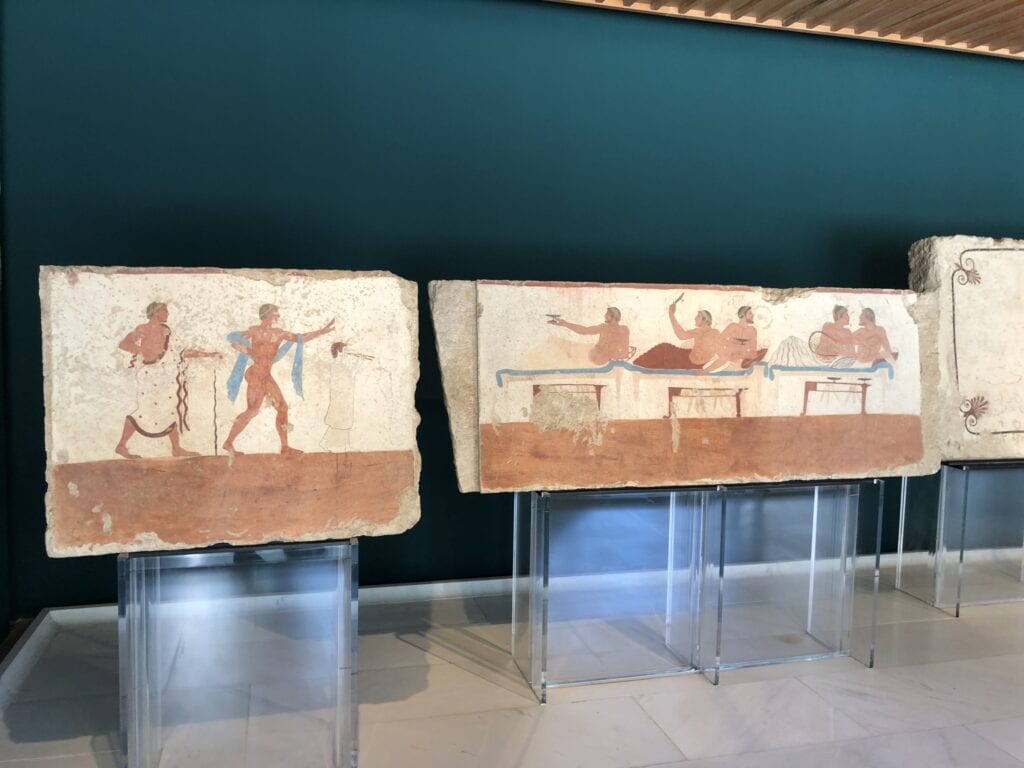
Previous Tour
Booking for paestum: the city of poseidon – virtual guided tour, tripadvisor traveller’s choice.

The Grand Tour
The Grand Tour Europe Ltd
Unique Guided Tours
Boutique Tour Operator
Head Office 2 White Friars, Chester, CH11NZ, UK
Chester +441244913326
Rome +390692928173
Venice +390418876986
Registered No: 08171172
VAT GB177128492

I have read and agree to the terms & conditions
Email address

- Amalfi Coast
- Pompeii - Mt. Vesuvius
- Experiences
Day Trip to Paestum
Visit the famous temples of Paestum from Sorrento

Paestum, located about 70 kilometers south of the Sorrentine Peninsula, was founded by ancient Greeks in the 7th century BC and is famous still today for the perfectly preserved Greek temples, which have recently been declared a UNESCO World Heritage Site.
Getting to Paestum
The trip from Sorrento to Paestum is rather long, so the best option is to book a private driver for a car tour or rent a car and drive yourself. To reach Paestum by public transportation, you will need to travel to Naples and take the train from there; the archaeological ruins are about a 15 minute walk from the train station.
A Gourmet Side Trip If you are travelling by car, don't miss the opportunity to stop at one of the many artisan cheesemakers along the road, specialized in making the area's famous mozzarella di bufala , or buffalo mozzarella. We suggest visiting Vannulo, which offers tours of the buffalo farm, a farm shop with a variety of artisan cheeses, a farm restaurant featuring dishes based on farm products, and a gelateria specialized in buffalo milk gelato.
The History of Paestum
The temples at Paestum were built by ancient Greeks who initially settled at Sibari in Calabria before beginning to expand their territory along the coastline of southern Italy, creating what is now known as Magna Grecia. Paestum was once called “Poseidonia” in honor of the god of the sea, protector of sailors. It reached its glory around 500 BC, but by the 4th century BC the area had begun to experience flooding caused by sediment at the mouth of the river Salso, which ran along the walls of the city. Over the centuries, residents began to leave the city until it was finally abandoned completely between 800 and 900 AD.
Ironically, the abandonment of the city was a lucky stroke for the temples of Paestum, which were left intact over the millenia. They were gradually rediscovered beginning in the 1700's by travellers on the Grand Tour, and in 1907 the first archaeological digs began, which lasted into the 1970's.
Visiting the Temples of Paestum
Tickets: EUR 7 Hours: 8:45 am to an hour before sunset
Buy your Paestum tickets online
After entering through the main gate, you will first come upon the “Temple of Ceres”, once dedicated to the Goddess of Athens. Continue south, passing the forum, a group of houses, and the amphitheater, all of which offer a view into daily life during Roman times. The Temple of Neptune (or Poseidon in Greek times) is located to the south, and is almost perfectly preserved. The adjacent Temple of Hera has been transformed into a Catholic basilica.
Take time to visit the site's archaeological museum, where the objects unearthed during excavations are displayed, including the famous fresco found in the Tomb of the Diver.
Wonders of Italy: Paestum
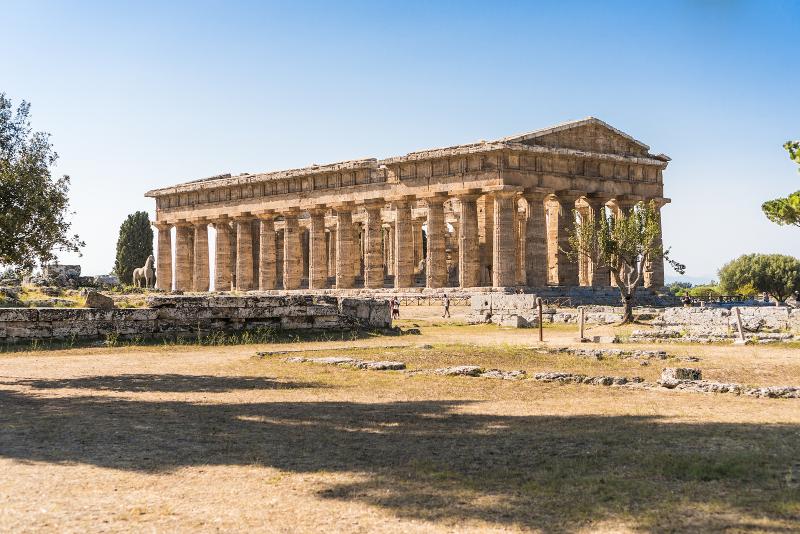
Use player to listen to Italian version
“You can’t trust books if you really want to understand these temples… you have to come here, walk among the ruins, and then everything will spring back to life…”
Thus wrote Goethe while visiting Paestum, home to one of Italy’s most incredible archaeological sites.
Founded by Greek colonists coming from Sybaris, on the Ionian coast of Calabria in 600 BC, Paestum was originally named Poseidonia, to honor Poseidon, the Greek God of the seas. The Greeks were looking for a new port on the Thyrrenian Sea to expand their trading power, which they did, while erecting buildings that have few equals in the world.
Indeed, Paestum, thanks to its three ancient Greek temples, some of the best preserved in the world, has been included by Unesco in its World Heritage list.
The most ancient temple dates back to 550 BC and is dedicated to Hera, the goddess of fertility and life; on the opposite side of town is the temple of Athena; the largest of the three is the temple dedicated to Poseidon, which is 60 meters long, 24 meters large and 18 meters high, the equivalent of a six-story building.
Paestum later became a Roman city (that’s when it took the name Paestum), and was abandoned in the Middle Ages. The ruins were rediscovered in the 1760s, but not fully excavated until the 1950s. After being discovered, Paestum became a popular destination on the Grand Tour.
Not as popular as the archeological site of Pompeii, located in the same southern Italian region of Campania, Paestum makes it easier to absorb the atmosphere of the place, if you take some time to walk among the ruins, especially at sunset, when the travertine columns reflect the light of the sun.
You can get to Paestum from Naples by train in about an hour. It’s then a 15-minute walk to the archeological area and the museum.
"Non ci si può fidare dei libri per capire davvero questi templi... bisogna venire qui, camminare tra le rovine, e allora tutto riprende vita..."
Così scrisse Goethe della sua visita a Paestum, sede di uno dei siti archeologici più straordinari d’Italia.
Fondata da coloni greci provenienti da Sibari, sulla costa ionica della Calabria, nel 600 a.C., Paestum era originariamente chiamata Poseidonia, in onore di Poseidone, il dio greco dei mari. I greci stavano cercando un nuovo porto sul Mar Tirreno per espandere il loro potere commerciale e ci riuscirono, erigendo nel frattempo edifici che hanno pochi eguali nel mondo.
Paestum, infatti, grazie ai suoi tre antichi templi greci, tra i meglio conservati al mondo, è stata inserita dall'Unesco nell’elenco del Patrimonio Mondiale dell’Umanità.
Il tempio più antico risale al 550 aC ed è dedicato ad Hera, dea della fertilità e della vita; sul lato opposto della città si trova il tempio di Atena; il più grande dei tre è il tempio dedicato a Poseidone, che è lungo 60 metri, largo 24 e alto 18, l'equivalente di un edificio di sei piani.
Paestum divenne in seguito una città romana (da qui prese il nome di Paestum), e fu abbandonata nel Medioevo. Le sue rovine furono riscoperte nel 1760, ma non completamente dissotterrate fino agli anni '50. Dopo essere stata scoperta, Paestum è diventata una meta ambita del Grand Tour.
Meno frequentata del sito archeologico di Pompei, situato anch’esso nella regione Campania del sud d’Italia, a Paestum è più facile assorbire l'atmosfera del luogo, soprattutto se ci si prende un po’ di tempo per passeggiare tra le rovine, in particolare al tramonto, quando le colonne di travertino riflettono la luce del sole.
Paestum si raggiunge in treno da Napoli in circa un'ora. L'area archeologica e il museo distano 15 minuti a piedi dalla stazione.
More Dual Language Articles...

Italian Language eBooks

Language Schools
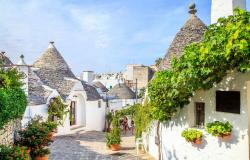

Day Trip to Paestum Italy 2024 – Ancient Greek Temples
The Paestum Archaeological Park (Parco Archeologico di Paestum) in Paestum Italy, is one of the finest examples of preserved Greek temples in all of Italy. So, if you are wondering if a day trip to Paestum Italy is worth it, without hesitation, the answer is YES!
This is a UNESCO World Heritage site located in Italy’s Campania region. It is approximately 1 ½ hour south of Napoli (Naples). We have visited Paestum Italy several times over the years and each time we are in awe of the blend of antiquities with nature.
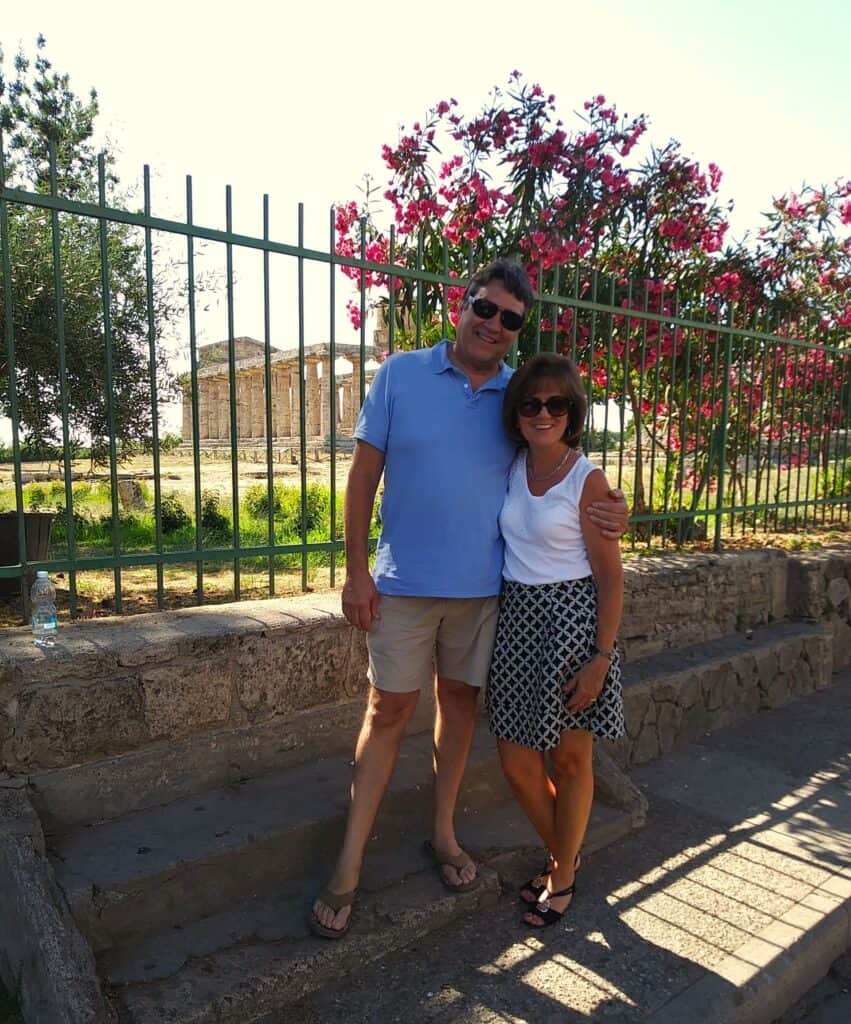
In this guide we will give you what to see while visiting the park, when the park is open, how to purchase tickets, how to get there, tour options, and more. Let’s get started!
Disclosure: Some of the links below are affiliate links. If you make a purchase using one of the links, we may earn a commission, at no additional cost to you. Please see our Disclaimer for additional information.
Day Trip to Paestum Italy 2024 – Ancient Greek Temples – What to See
For some historical context, the Greeks founded the city in the 7th century BC, originally naming it Poseidonia. When later conquered by the Romans, the name was changed to Paestum.
Due to its proximity to the Tyrrhenian Sea, the area experienced flooding and marsh formations. The city was abandoned during the Middle Ages and remained so until its rediscovery in the 18th century. Amazingly the ancient Greek temples were still intact. This is the unique feature of the park – the three Greek temples in Paestum Italy.
1. Temple of Hera (Heraion or Basilica)
The Temple of Hera, also known as the Heraion or Basilica, is one of the oldest and most well-preserved Doric temples in the world. Dedicated to the goddess Hera, the temple dates back to the 6th century BCE.
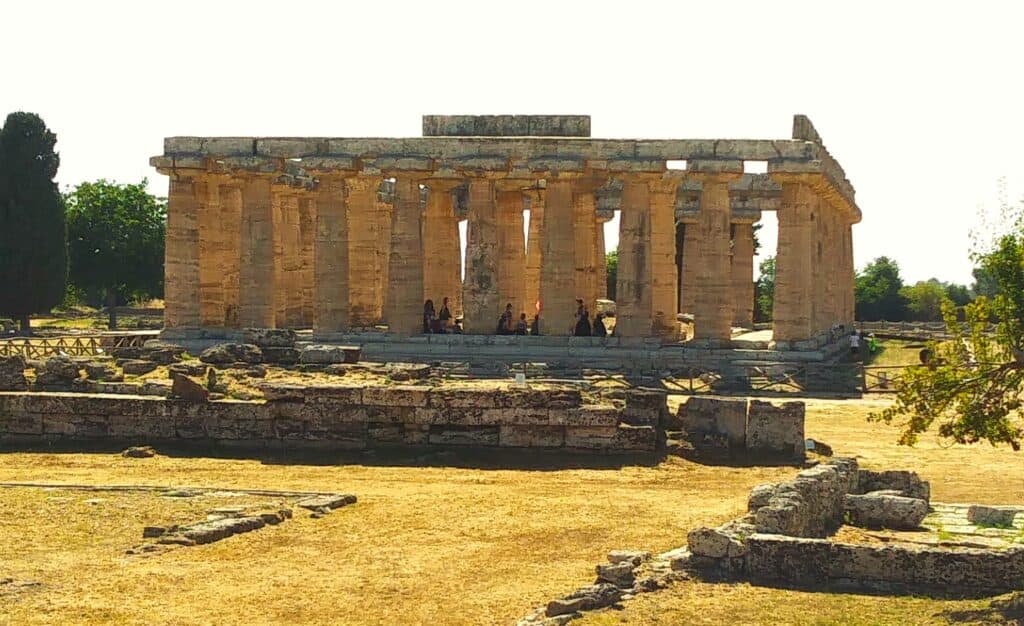
This temple is wider than most Greek temples. But it follows the classic Doric architectural style with nine columns on the facades and eighteen on the longer sides. It housed various artifacts and sculptures which are now in the Museum.
And the best part, you can walk into and through this temple. A truly amazing experience.
2. Temple of Hera II (Neptune or Poseidon)
Also known as the Temple of Neptune or Poseidon, this Doric temple is devoted to the god of the sea. Slightly younger (450 BC) than the Temple of Hera, it highlights the advanced architectural skills of the ancient Greeks. Its design is based on the Temple of Zeus in Olympia.
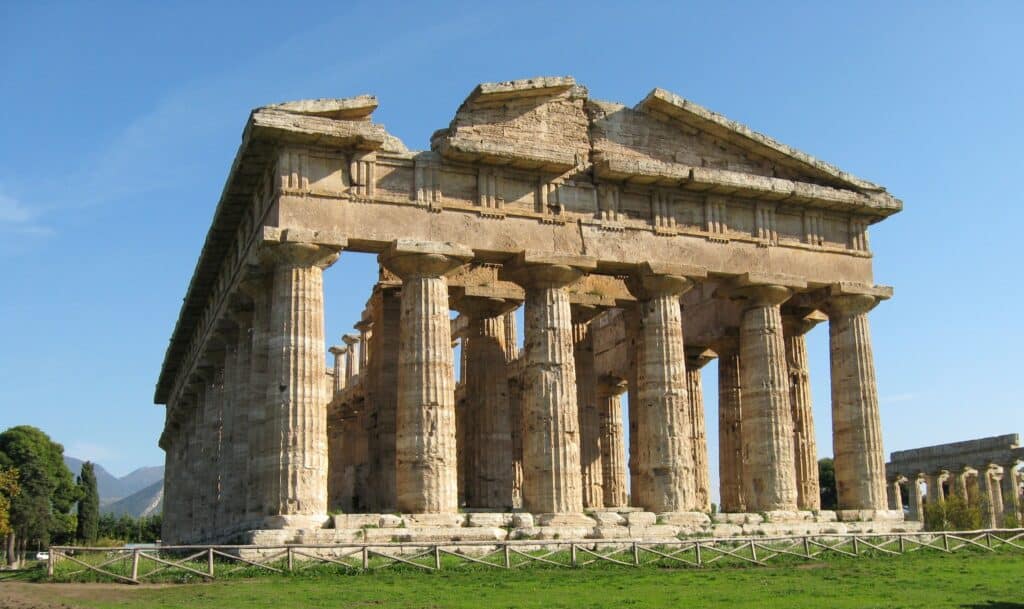
The temple follows more of a transitional Doric architectural style with six columns on the facades and fourteen on the longer sides. It features a more intricate design compared to the Temple of Hera. It has a similar Doric style with fewer columns but boasts a higher level of decoration, including detailed metopes and triglyphs.
You can walk through and around this temple too.
3. Temple of Athena (or Ceres)
The Temple of Athena, frequently associated with the goddess Ceres, stands as the smallest among the three primary temples in Paestum. This Doric temple, featuring Ionic elements, dates back to around 500 BC. Constructed on the highest point north of the city center, it holds a prominent position in the city.
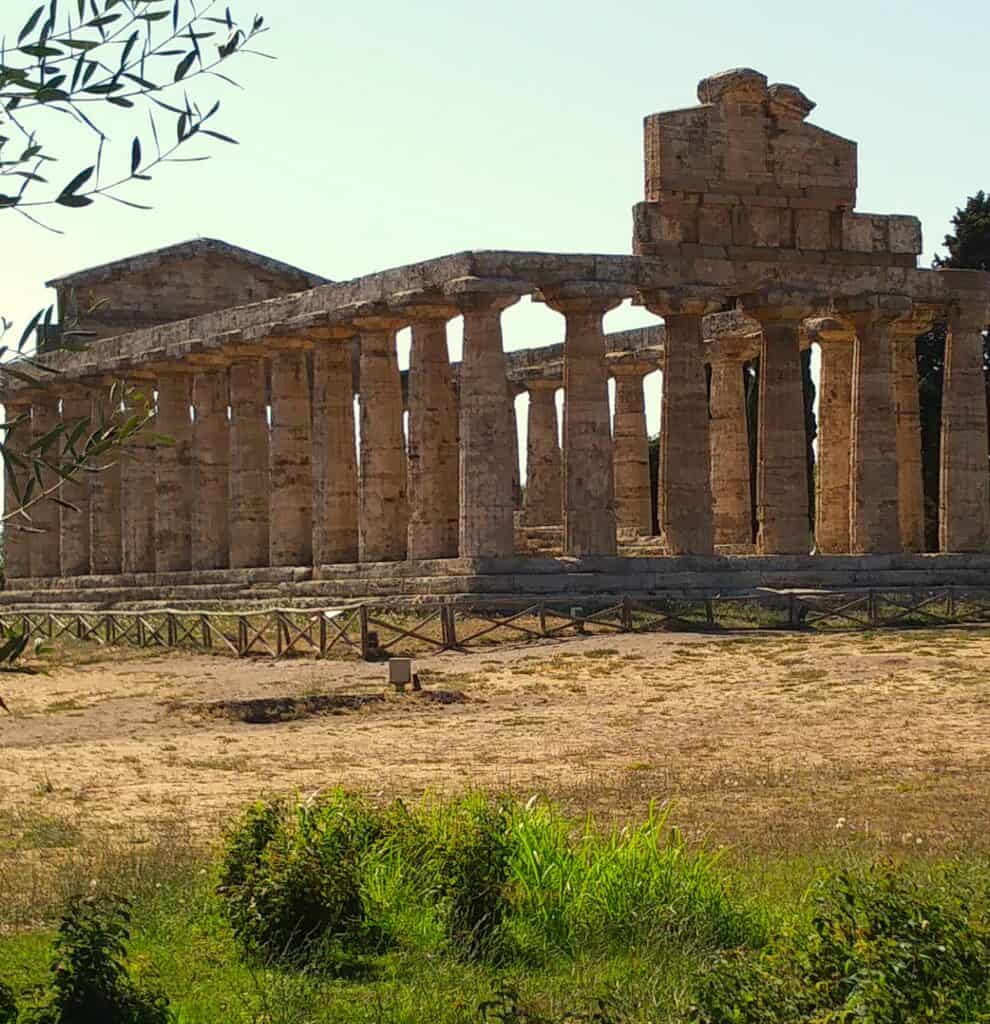
This temple follows a similar architectural style to the others, with a pronaos (porch), cella (main chamber), and opisthodomos (rear porch). It has six columns on the façade and thirteen on the longer side.
Special Note: On September 9, 1943, Paestum became the landing site for the U.S. 36th Infantry Division during the Allied invasion of Italy. The battle between the German and the US forces lasted nine days, with the Germans eventually retreating to the north. To avoid damage, both sides agreed not to bomb the temples, so the Allied forces established Red Cross first aid tents in and around them.
4. Roman Amphitheater
In addition to the temples, Paestum features a well-preserved Roman amphitheater dating from the 3rd century BCE. It reflects the influence of Roman architecture in the region during later periods.
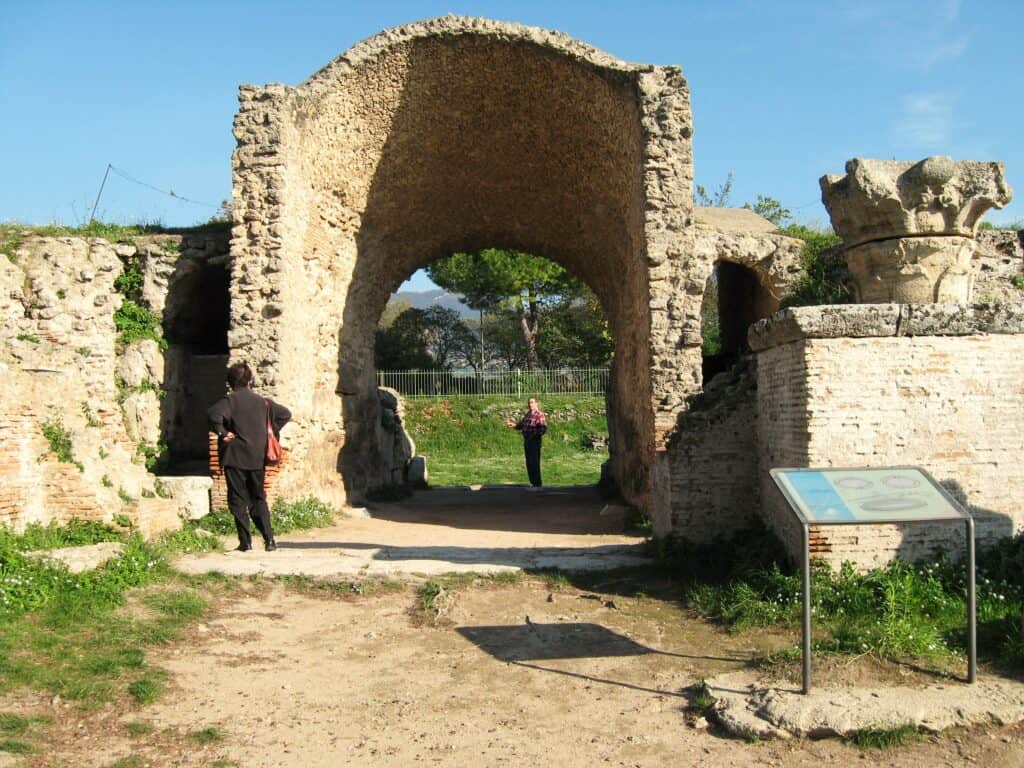
The amphitheater as well as other Roman ruins, are located between Temple Athena to the north and Temple Hera’s I and II to the south. This would have been the center of Roman life.
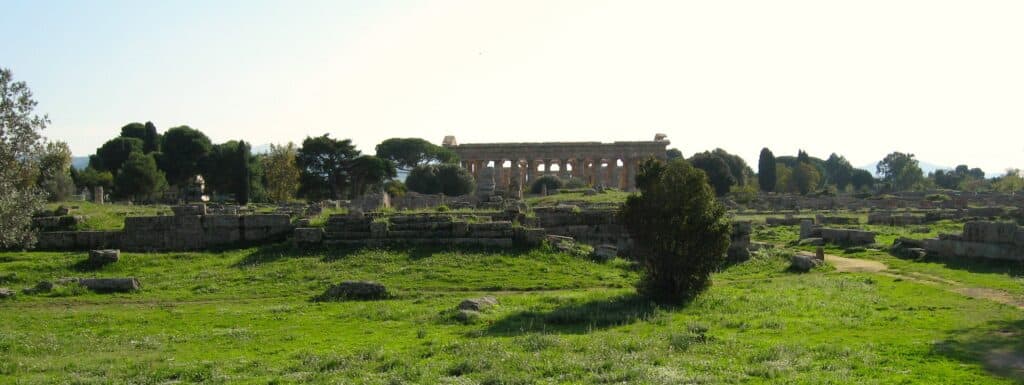
The Via Sacre, made of limestone blocks, is the north to south street in ancient Paestum. You will walk along this street while visiting the archaeological sites.
5. Archaeological Museum of Paestum
While not a temple, the Archaeological Museum adjacent to the park is essential for understanding the history of Paestum Italy. In late 2023, the Museum reopened after renovations.
It houses a remarkable collection of Greek, Lucanian and Roman artifacts, including sculptures, pottery, and tomb paintings. The most famous is the Tomb of the Diver, a fresco painted on the top slab of a tomb from the 5 th century BC.
6. Chiesa Della SS Annunziata (Basilica Paleocristiana dell’Annunziata)
This small Romanesque church, located in the Paestum Archaeological Park, dates back to the 5th century AD. Many people overlook it, but I recommend visiting it after you have seen the temples.
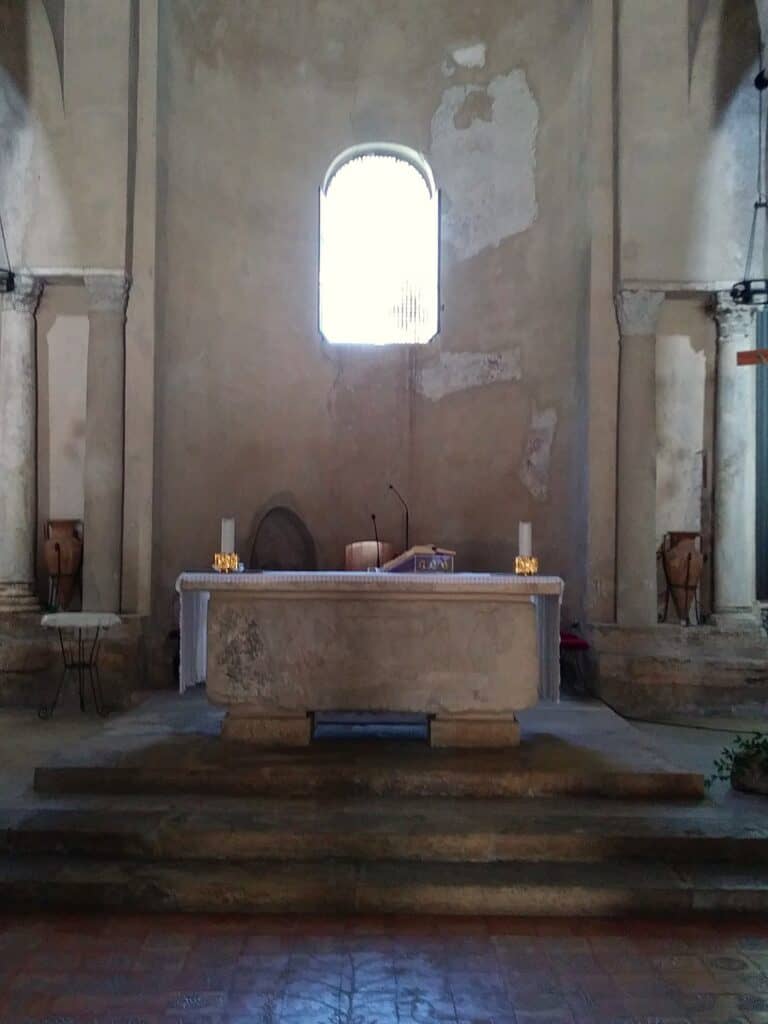
It is next to the Archaeological Museum. They used stone from the Paestum archaeological site to construct the chapel.
When is the Paestum Italy Archaeological Park and Museum Open
The Paestum Archaeological Park and Museum have summer, fall and winter hours as follows:
- From April through August, the opening hours are 8:30 am to 19:30 (7:30 pm), with the last ticket issued at 18:50 (6:50 pm).
- For September through March, the park opens at 8:30 am, and closing hours vary based on daylight. Please check the Paestum website for specific closing hours.
- On the 1st and 3rd Monday of every month, the Museum opens at 8:30 am and closes at 13:40 (1:40 pm), with the last ticket issued at 13:00 (1:00 pm).
- Closed on December 25 and January 1.
I visited Paestum in the summer and the fall. During the summer, it is best to visit during a weekday to avoid the crowds on the weekend. The park is wide open with little shade, so during the hot summer days, wear a hat, use sun lotion, and bring water. In addition, it is advisable to wear comfortable shoes as you will be walking along stone paths.
Tickets for the Paestum Archaeological Park and Museum
You can buy tickets and audio guides at the Archaeological Museum or at the ticket office located at Porta Principale, in front of Temple Hera II. The ticket office provides a storage room for backpacks and luggage, along with restroom facilities. Additionally, tickets are available for online purchase and remain valid for 3 days.
Please note : the Paestum website is temperamental – sometimes it connects and sometimes it does not – just letting you know in advance.
You can purchase tickets for the Archaeological Park and Museum together or separately if you prefer to visit only the Museum or only the Park. Please refer to the Paestum website for current ticket prices.
I have been to Paestum Italy several times over the years, and I have always purchased my tickets onsite without any long delays to entry into the park. Plan on spending several hours visiting the park.
How to Get to Paestum Italy
You can reach Paestum via car or train. I have done both. With a car, you have the freedom to come and go as you please. With a train, you do not need to worry about traffic, directions, or parking. So, depending on where you come from, the choice is yours.
Address: Via Magna Graecia, 919, 84047 Capaccio SA, Italy
Click on the Google Maps for directions to Paestum Italy. There are several free parking areas surrounding the archaeological site. If you need to rent a car while in Italy, I recommend using Discover Cars .
If you are traveling from Napoli, the ride is about 1.5 hours, from Salerno about 30 minutes. From the south of Italy, the ride from San Nicola Arcella (Scalea – S. Domenica Talao station) is 2 hours or less depending on the train line service.
Regional and InterCity train lines , operating from early morning until late at night, provide service to Paestum. The station’s name is “Paestum – Stazione”.
When leaving the station, head west along Via Porta Sirena. The entrance to the Paestum Archaeological Museum and Park is 1km (0.6 miles) from the station through the Porta Sirena gate.
We walked along the road to the Paestum archaeological park, and it is a pleasant, flat walk.
Tours of Paestum Italy Archaeological Park and Museum
If you want to take a tour of the park, the only tour offered is a free guided tour in Italian called “ The Argonauts Footpath: a Walk from Temples to Sea” . It is available on the first Sunday of every month at 10:30am. You can get the free ticket from the Museum ticket office.
There are several independent tours available for your visit to Paestum. Below are some options that you may consider.
- ➡️ Paestum: Small Group Tour with An Archaeologist with Tickets
- ➡️ Private Tour Paestum: Temples and Museum Tour with Archaeologist Guide
- ➡️ Paestum Small Group Tour with An Archaeologist – 2 Hours
Where to Eat and Shop
Along the Via Magna Grecia, there are several souvenir shops, cafes, and restaurants. If you are hungry or need a café or gelato, this area is perfect for a break.

We have eaten lunch here with a wonderful view of the temples in the background. If you like buffalo mozzarella, then this is the area for you. There are local farms in Paestum that make the mozzarella!
My Trip Planning Resources These are the companies that I use when planning our trips: – Flights: WayAway – Hotel Reservations: Booking.com or Hotels.com – Vacation Rentals: VRBO – Rental Cars: DiscoverCars.com – Train Tickets: Rail Europe – Tours: Viator , Get Your Guide and GuruWalk – Travel Insurance: VisitorsCoverage – Airport Lounge Access Program: Priority Pass If you choose to buy through any of the provided links, we may receive a commission without any extra charges to you. Explore our Travel Resources page for additional service suggestions.
Final Thoughts: Day Trip to Paestum Italy 2024 – Ancient Greek Temples
This is a place where you will say WOW. Out of nowhere, there are 3 huge temples completely intact, in an open field with lots of stone ruins mixed in. I expected to see these structures in Greece, not Italy. It is a fascinating journey into the ancient world and is well worth making a day trip to see this remarkable site.
If you would like assistance in planning your visit to Paestum Italy, we would be happy to help. Please refer to our Travel Planning services for further information or send us an email ..
If you want to explore more in Southern Italy , check out our following posts:
- 29 Best Things To Do In Napoli (Naples, Italy 2024) By A Frequent Visitor – Practical Travel Concepts
- Is San Nicola Arcella in Calabria Italy Worth Visiting? (By A Local) – Practical Travel Concepts
- Is Tropea in Calabria Italy Worth Visiting? (By A Frequent Visitor) – Practical Travel Concepts
- Is Maratea Italy Worth Visiting? (By a Local)
Hello, I’m Janet, the owner and writer behind Practical Travel Concepts. With over 40 years in various corporate leadership roles and owning multiple businesses, I’ve now shifted gears to pursue my passion for travel. My focus is on writing straightforward blog posts about my travels and helping clients plan their trip itineraries. I aim to share practical travel insights and tips to enhance your adventures based on my firsthand experiences exploring the world with my husband and family.

Paestum Tour
Discover the wonders of the city of Poseidonia
Paestum, a bit of history
We are in the 7th century BC Pestum, then known as Pesto, was built by the Greeks called by the founders Poseidonia in honor of Poseidon, but very devoted to Athena and Era. After its conquest by the Lucanians it was called Paistom, to then assume, under the Romans, the name of Paestum. Under Roman rule important public works were carried out
Surely the tour of Paestum can only begin with the famous excavations that gave it luster, and ends with a visit to the buffalo mozzarella production plant. Next to the archaeological site of Paestum you can book a guided tour and take a complete tour of the excavations to learn more about the history of the city. You can have the possibility to book a guide or enter independently within the excavations.
What to see in Paestum: the Monuments and Places of Interest
- The sanctuary of Hera at the mouth of the Sele
- Temple of Hera I
- Temple of Athena
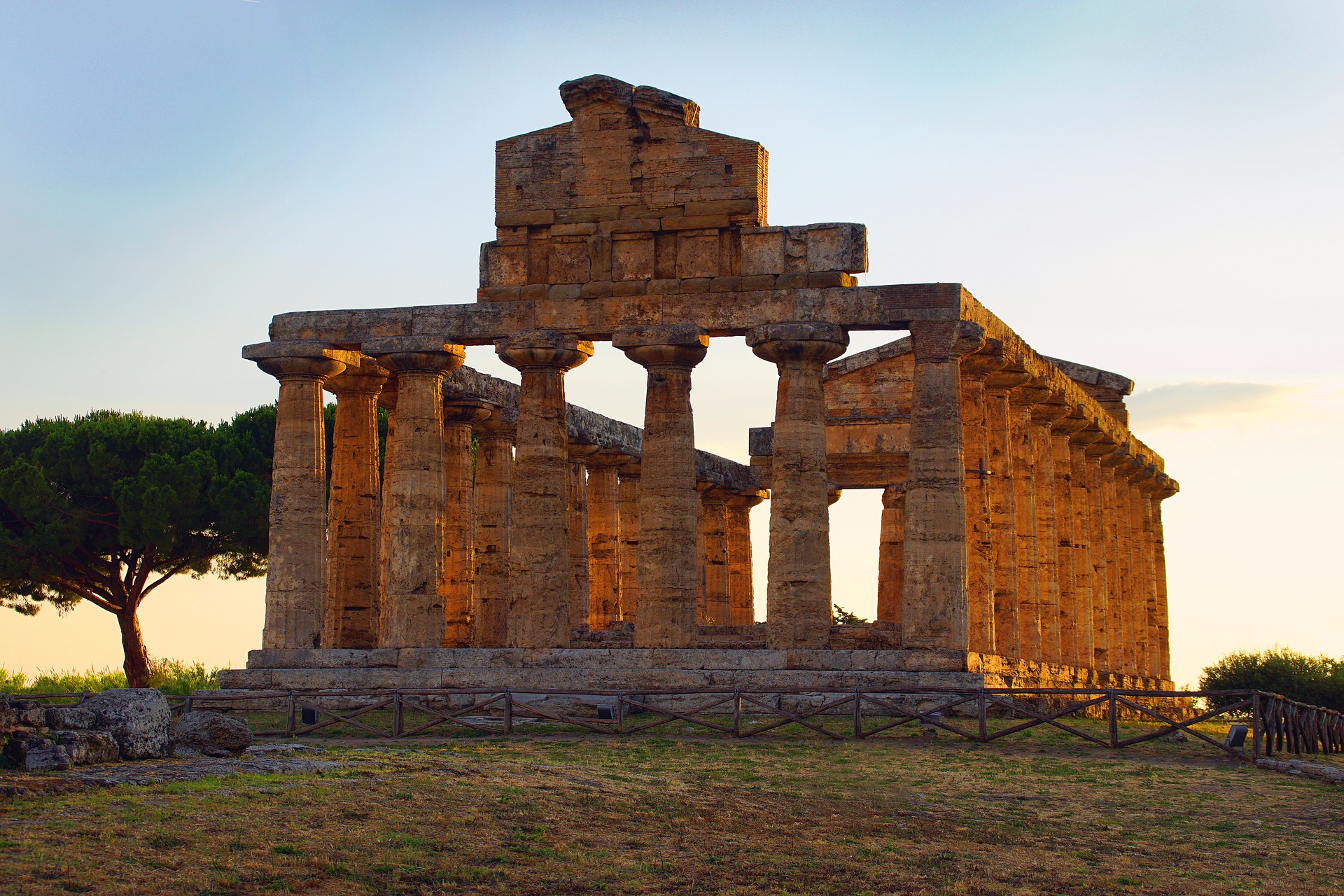
Contact Details
If you have a story to share or a question that has not been answered on our website, please get in touch with us via contact details listed below or fill in the form on the right.
Get in Touch
Type of service * Tour Transfer Name and Surname * Telephone * E-mail * Confirm E-mail * City Country United States Canada Mexico United Kingdom ----- Afghanistan Albania Algeria American Samoa Andorra Angola Anguilla Antigua and Barbuda Argentina Armenia Armenia Aruba Australia Austria Azerbaijan Azerbaijan Bahamas Bahrain Bangladesh Barbados Belarus Belgium Belize Benin Bermuda Bhutan Bolivia Bonaire Bosnia and Herzegovina Botswana Bouvet Island (Bouvetoya) Brazil British Indian Ocean Territory (Chagos Archipelago) British Virgin Islands Brunei Darussalam Bulgaria Burkina Faso Burundi Cambodia Cameroon Cape Verde Cayman Islands Central African Republic Chad Chile China Christmas Island Cocos (Keeling) Islands Colombia Comoros Congo Congo Cook Islands Costa Rica Cote d'Ivoire Croatia Cuba Curaçao Cyprus Cyprus Czech Republic Denmark Djibouti Dominica Dominican Republic Ecuador Egypt El Salvador Equatorial Guinea Eritrea Estonia Ethiopia Falkland Islands (Malvinas) Faroe Islands Fiji Finland France French Guiana French Polynesia French Southern Territories Gabon Gambia Georgia Georgia Germany Ghana Gibraltar Greece Greenland Grenada Guadeloupe Guam Guatemala Guernsey Guinea Guinea-Bissau Guyana Haiti Heard Island and McDonald Islands Holy See (Vatican City State) Honduras Hong Kong Hungary Iceland India Indonesia Iran Iraq Ireland Isle of Man Israel Italy Jamaica Japan Jersey Jordan Kazakhstan Kazakhstan Kenya Kiribati Korea Korea Kuwait Kyrgyz Republic Lao People's Democratic Republic Latvia Lebanon Lesotho Liberia Libyan Arab Jamahiriya Liechtenstein Lithuania Luxembourg Macao Macedonia Madagascar Malawi Malaysia Maldives Mali Malta Marshall Islands Martinique Mauritania Mauritius Mayotte Micronesia Moldova Monaco Mongolia Montenegro Montserrat Morocco Mozambique Myanmar Namibia Nauru Nepal Netherlands Netherlands Antilles New Caledonia New Zealand Nicaragua Niger Nigeria Niue Norfolk Island Northern Mariana Islands Norway Oman Pakistan Palau Palestinian Territory Panama Papua New Guinea Paraguay Peru Philippines Pitcairn Islands Poland Portugal Puerto Rico Qatar Reunion Romania Russian Federation Rwanda Saint Barthelemy Saint Helena Saint Kitts and Nevis Saint Lucia Saint Martin Saint Pierre and Miquelon Saint Vincent and the Grenadines Samoa San Marino Sao Tome and Principe Saudi Arabia Senegal Serbia Seychelles Sierra Leone Singapore Sint Maarten (Netherlands) Slovakia (Slovak Republic) Slovenia Solomon Islands Somalia South Africa South Georgia & S. Sandwich Islands Spain Sri Lanka Sudan Suriname Svalbard & Jan Mayen Islands Swaziland Sweden Switzerland Syrian Arab Republic Taiwan Tajikistan Tanzania Thailand Timor-Leste Togo Tokelau Tonga Trinidad and Tobago Tunisia Turkey Turkey Turkmenistan Turks and Caicos Islands Tuvalu U.S. Virgin Islands U.S. Minor Outlying Islands Uganda Ukraine United Arab Emirates Uruguay Uzbekistan Vanuatu Venezuela Vietnam Wallis and Futuna Western Sahara Yemen Zambia Zimbabwe Your Tour Tour Napoli Tour Amalfi Tour Positano Tour Sorrento Tour Ravello Tour Salerno Tour Caserta Tour Vesuvio Tour Positano Sorrento Pompei Tour Sorrento Positano Amalfi Tour Positano Amalfi Ravello Tour Pompei Ercolano Tour Ercolano Vesuvio Tour Pompei Napoli Tour Napoli Caserta Tour Date Number of passengers 1 2 3 4 5 6 7 Pick Up City Drop off location Pick up From ---- Hotel Airport Railway Station Port Other More details about your request I've read the privacy policy and accepted it
Privacy Overview

IMAGES
COMMENTS
Followed by a visit to the National Archaeological Museum of Paestum, in which the most important examples of Greek art are preserved. Inside the museum you can admire the elements that served as decoration of the temples and some of the most beautiful painted tombs of Campania. ... Naples Grand Tour by Grand Tour Experience Srls P.Iva ...
The Grand Tour was the principally 17th- to early 19th-century custom of a traditional trip through Europe, with Italy as a key destination, ... Naples, Pompeii, Turin, Milan, Cremona, Siena, Bologna, Vicenza, Paestum, Urbino, Tivoli and concluding at a Venetian masked ball.
Discover the wonders of Paestum with this comprehensive guide to visiting the ancient town! Explore the well-preserved Ancient Greek temples, dating back to 650 to 450 CE, and be captivated by the enigmatic 5th century BC "Tomb of the Diver" fresco. Don't miss the extraordinary collection of artifacts in the Archaeological Museum. Read on for the ultimate guide to Paestum!
Paestum was "re-discovered" in the 18th century, when poets like Goethe, Shelley, Canova, and Piranesi visited and wrote about the ruins while on the "Grand Tour." Today, Paestum contains an adjacent archaeological museum, alongside the old town, which houses collections of ancient artifacts.
10. Paestum 3 Hours Archaeological Private Tour. Explore the stunning ruins of Paestum, including its magnificent Doric temples, amphitheater, forum, and markets. After…. 11. Private tour to Paestum with private guide and Buffalo Mozzarella farm. Leave the hotel to Paestum, the capital of the buffalo mozzarella cheese.
Grand Tour Amalfi Coast, Naples, Capri, Pompeii, Salerno, Paestum and Caserta. 1. Historical Tours. from . $1,344.12. per adult. The ruins of Paestum private tour: best preserved temples in the world (Unesco) 1. Private and Luxury. from . $267.56. per group (up to 15) Paestum Archeological Park & Museum Skip the Line Tour with a Native Guide .
2h Temple and Archaeological museum of Paestum guided tour; Paestum Temples and Museum Tour with guide; Paestum and mozzarella farm tour from Naples (indeed, this is mozzarella di bufala land!) Paestum and buffalo farm day tour from Sorrento; What to see near Paestum. Paestum is less than an hour South of Salerno, the getaway town to the Amalfi ...
Stato. Paestum riemerge dall'oblio a metà del Settecento, grazie a studiosi, giovani e cosmopoliti, che spostano le mete del Grand Tour formativo verso il sud d'Italia. Rispetto alle allora recenti scoperte delle dissepolte città di Ercolano (1738) e Pompei (1748), la greca Poseidonia era sempre stata lì, sommersa da una rigogliosa natura ...
It was a common destination on the Grand Tour of the 17th to 19th centuries, as an example of the Ancient Greek heritage. In these times, in fact, Greece was part of the Ottoman Empire. ... 1 Oleandri Resort Paestum - Hotel Village Residence Club, Via Poseidonia 177. With a large outdoor pool, a hot tub and children's play area, the hotel is ...
Start in Salerno, this 8 day tour package taking you through Naples, Amalfi Coast, Pompeii, Capri, Paestum and Caserta. We'll visit Positano, the most well-known summer resort area on the whole peninsula where you have to be sure to buy one of the straw handbags or handmade sandals for which Positano is famous.
An expert guide will accompany you to discover the 2,500-year-old religious architecture on a journey beyond the confines of time. This will be followed by a visit to the National Archaeological Museum of Paestum, in which the most important examples of Greek art are preserved. Inside the museum you can admire some of the relics that served as ...
Paestum is home to three of the most spectacular ancient Greek temples in the world. With this tour, visit these Doric treasures and learn how and why the Greeks erected them 2,500 years ago from your archaeologist guide. End with a stroll through the National Archaeological Museum to admire the collection of ancient art and decorated tombs, including the Tomb of the Diver.
Plan your trip in advance: Tickets to the Archaeological Park of Paestum sell out pretty quickly in the peak seasons (April to June).So, it is recommended to purchase skip-the-line tickets in advance, so you don't need to stand in long queues at the venue.. Opt for a guided tour: BY taking a guided tour, you can skip the long lines at the entry and straightaway visit Paestum Park with an ...
The Ancient Greek City of Poseidonia, later renamed Paestum or Pesto by the Romans, was a sort of El Dorado to the Grand Tour Travelers. Paestum it is now a Unesco World Heritage site, offers one of the most evocative experiences of antiquity, in this virtual tour we will discover its history and its ruins, but also the rare famous painted ...
Ironically, the abandonment of the city was a lucky stroke for the temples of Paestum, which were left intact over the millenia. They were gradually rediscovered beginning in the 1700's by travellers on the Grand Tour, and in 1907 the first archaeological digs began, which lasted into the 1970's. Visiting the Temples of Paestum. Tickets: EUR 7
Paestum later became a Roman city (that's when it took the name Paestum), and was abandoned in the Middle Ages. The ruins were rediscovered in the 1760s, but not fully excavated until the 1950s. After being discovered, Paestum became a popular destination on the Grand Tour. Not as popular as the archeological site of Pompeii, located in the ...
This is the unique feature of the park - the three Greek temples in Paestum Italy. 1. Temple of Hera (Heraion or Basilica) The Temple of Hera, also known as the Heraion or Basilica, is one of the oldest and most well-preserved Doric temples in the world. Dedicated to the goddess Hera, the temple dates back to the 6th century BCE.
We are in the 7th century BC Pestum, then known as Pesto, was built by the Greeks called by the founders Poseidonia in honor of Poseidon, but very devoted to Athena and Era. After its conquest by the Lucanians it was called Paistom, to then assume, under the Romans, the name of Paestum. Under Roman rule important public works were carried out.
In addition to our standard services, Grand Russia offers tours packages to Moscow and St Petersburg. You cannot resist our Two Hearts of Russia (7 Days &6 Nights), Golden Moscow (4 Days &3 Nights), Sochi (3 Days & 2 Nights), Golden Ring (1 Day & 2 Days), and many more. As a leading travel agency specializing in the tour to Russia and Former ...
Price per person. 641,69. View details. About the tour Reviews 10. 8 days / 7 nights. St. Petersburg Moscow. We offer you a unique opportunity to visit Russia's two largest cities, Moscow and St. Petersburg. This fascinating, week-long tour will take you to the historic Russian capitals that have always played the most important part in the ...
Overview:- Convenient departure and arrival times: departure 23:40, arrival 08:35 next day- Travel time: 9 hours- A real hotel on wheels: variety of travel s...
Grand Russia is a tour company providing original and professional private tours in Moscow, St. Petersburg, Golden ring towns and around Russia. We have a team of professionals who work in the field of tourism for more than 10 years. Guides from our team are all licensed and speak fluent English, German, French, Italian, Spanish, Portuguese ...